J. Parkes and Son
James Parkes, 1786 - 1877
Samuel Hickling Parkes, 1817 - 1896
Samuel Thomas Hickling Parkes, 1856 - 1939
James Ebenezer Moulton, 1844 - 1924
by Brian Stevenson
Last updated February, 2022
Based in Birmingham, England, Parkes produced good quality microscopes and other scientific equipment and supplies from the mid-1800s until well into the twentieth century. Recognizing the burgeoning market of students and middle-class amateurs, they focused on inexpensive instruments (Figures 1-7). A review of their entries in the 1862 London International Exhibition wrote that Parkes’ aim was to “produce convenient well-proportioned instruments at the lowest possible price, and … as their simplest forms of compound microscopes are extremely cheap … these may be the means of introducing a healthy and inviting pursuit amongst large classes to whom more efficient instruments would be obviously unattainable”.
Parkes also retailed a substantial number of microscope slides, including several sets of affordable, very good quality slides. Many of these are recognizable to modern collectors, although not marked with Parkes’ name (Figure 8-11). Parkes also distributed slides that were made by professionals such as John Norman.
James Parkes began his business in 1815. City directories described his initial business as a “gilt toy manufacturer” and “stamper and piercer”. It being that Parkes was not a goldsmith, “gilt” probably meant lacquered brass or other shiny metals. At that time, “toy” referred to small items, so he most likely made items such as snuff boxes, jewelry cases, and other metal devices. As described further below, James’ parents appear to have also been gilt toy makers, and his independent business coincided with his marriage. James’ only son, Samuel, became a partner in about 1846, forming Parkes and Son. A 24 page catalogue was produced in 1848, describing the business as “manufacturers of improved measuring tapes, land chains, mathematical instruments, miners’ and mariners’ compasses, watch keys, seals, &c., &c.”. An 1849 Birmingham city directory described them as “manfs. of mathematical instruments and gilt toys”. Their 1857 catalogue prominently featured microscopes and prepared slides (Figures 8 and 12). Samuel continued the business under the same name after his father’s death. Samuel had only one son, also named Samuel. That son, and a nephew, James Moulton, continued the business after the elder Samuel died. Moulton left the partnership in 1908, and Samuel T.H. Parkes continued alone for a number of additional years.
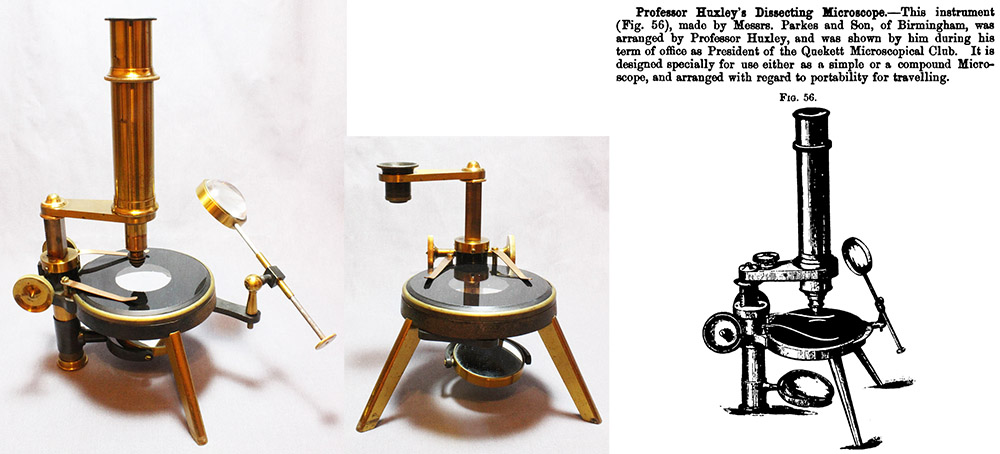
Figure 1A.
“Professor Huxley’s Dissecting Microscope”, by J. Parkes and Son. This model appeared in their 1862 catalogue, but not the 1857 edition. They continued production for many years – the engraving at the right is from an 1880 issue of “The Journal of the Royal Microscopical Society”. Images adapted with permission from http://www.microscope-antiques.com/huxley.html.

Figure 1B.
Circa 1860s "Students Microscope" (see Figure 12), by J. Parkes and Son. Adapted for nonprofit, educational purposes from an internet auction site.
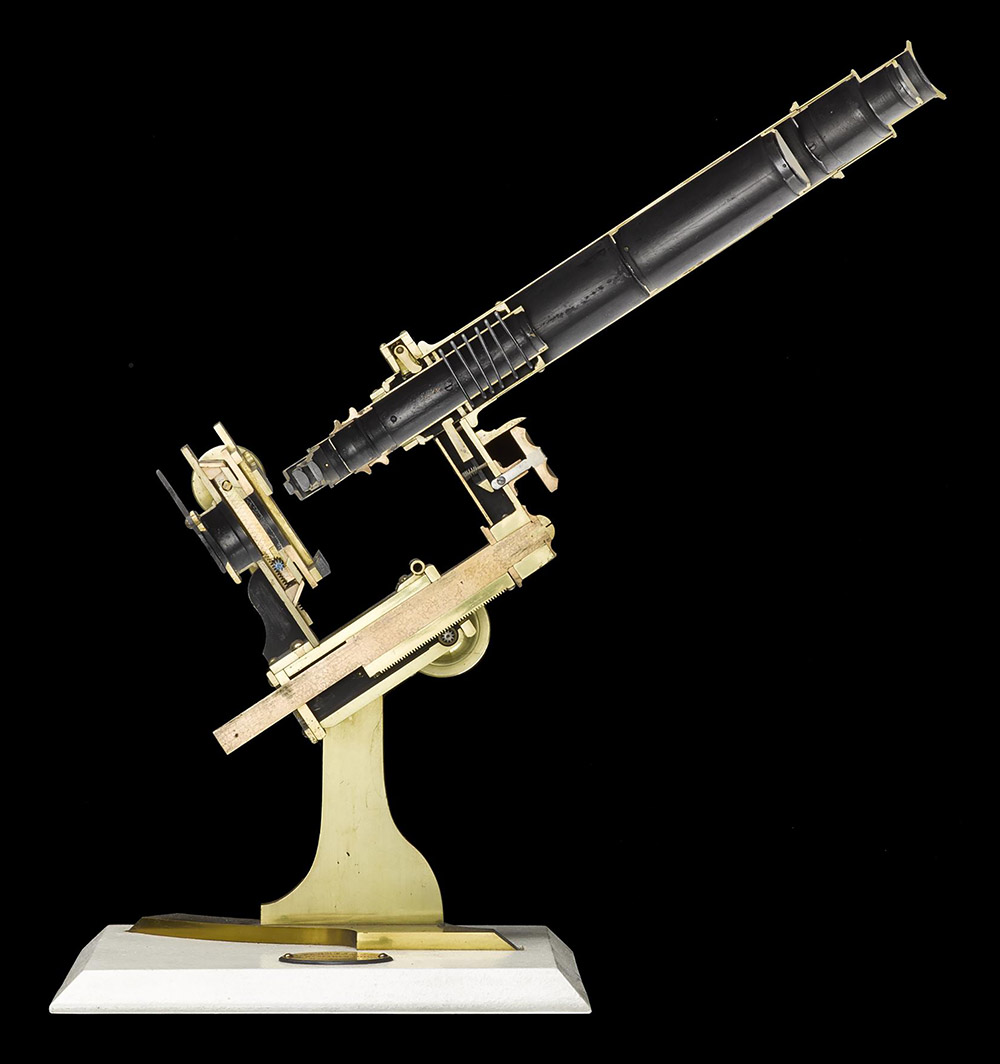
Figure 1C.
Dated 1864, a cut-away demonstration of a bar-limb compound microscope, manufactured and sectioned by James Parkes and Son. Note the multiple lenses of the achromatic objective, the field lens in the body tube, and the rack-and-pinion coarse focus. The model nicely illustrates the fine focus mechanism that was popular at the time. The external thumbscrew, mounted on the limb, puts pressure on an internal lever. This, in turn, adjusts the height of a tube that is inside the body tube. The objective is screwed into the internal tube. Thus, rotating the thumbscrew results in small movements of the objective towards or away from the specimen. An internal spring maintains keeps the internal tube in position. Adapted for nonprofit, educational purposes from https://www.nms.ac.uk/explore-our-collections/collection-search-results/microscope-achromatic-section/194046.
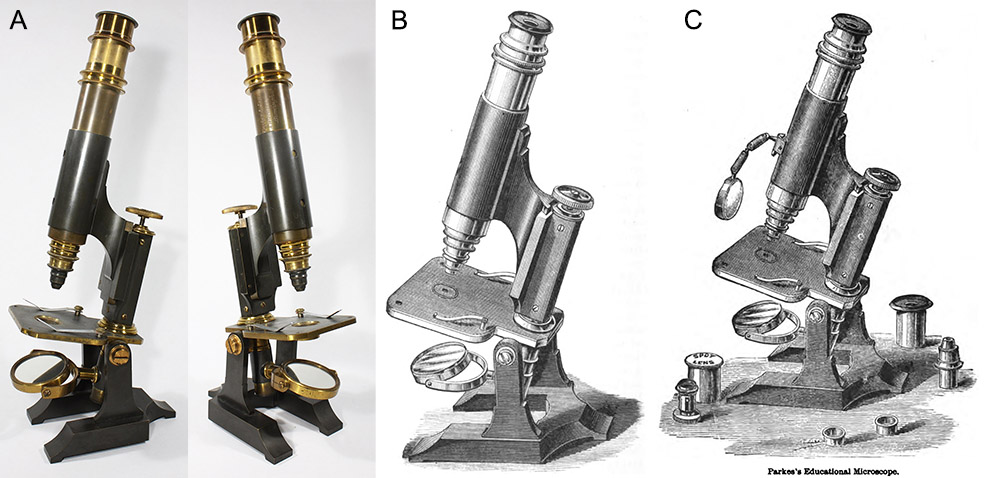
Figure 2.
(A) Parkes and Son’s “English Medical” microscope. (B) Engraving from an 1880 issue of “The Journal of the Royal Microscopical Society”.
(C) Engraving of their very similar “Educational” microscope (the only difference appears to be the attached bull’s-eye condenser lens). Adapted from W.B. Carpenter’s 1883 “The Microscope and Its Revelations”, Volume 1, 6th edition, USA version.
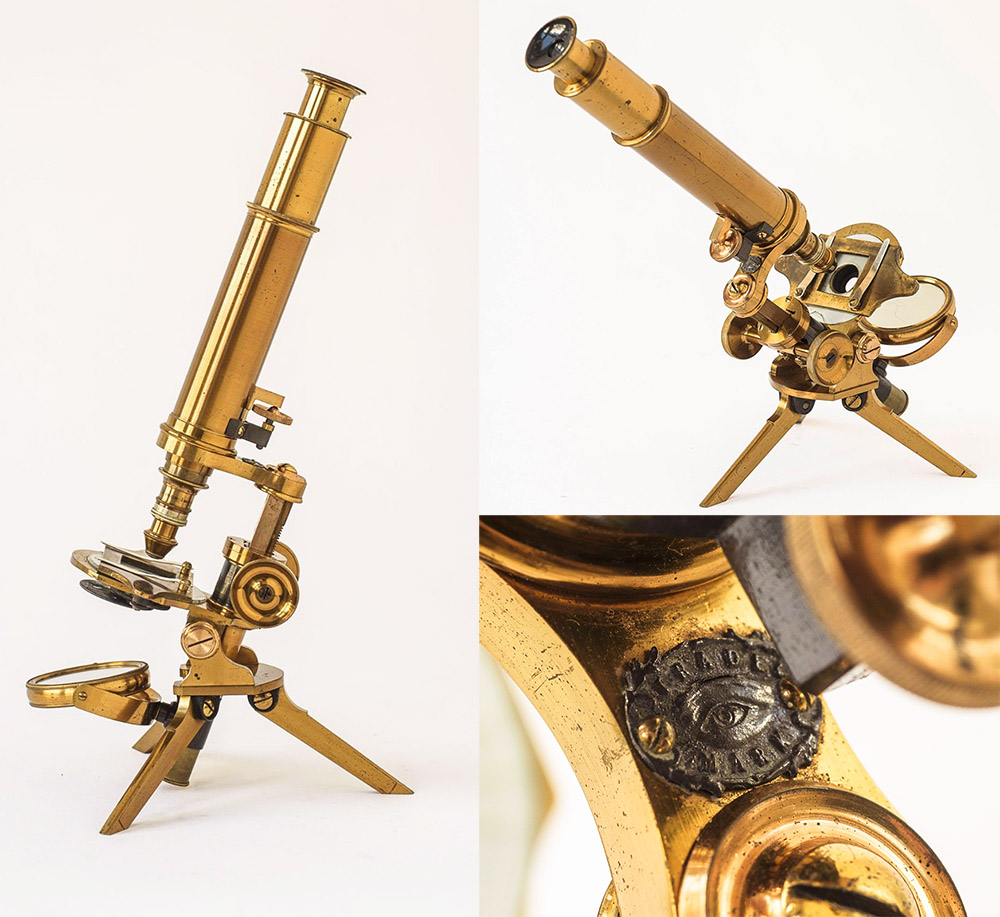
Figure 3.
An unknown model of microscope, with folding tripod legs. It is not signed, but bears the J. Parkes and Son trademark of an eye. It is not shown in either the 1857 or 1862 catalogues. Adapted for nonprofit, educational purposes from an internet auction site.
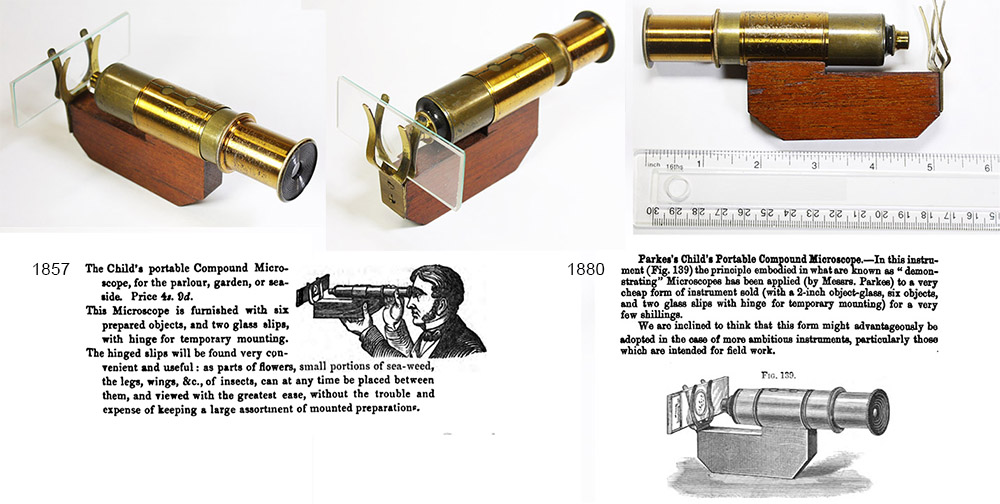
Figure 4A.
An inexpensive instrument, Parkes’ “Child’s Portable Compound Microscope”. It was illustrated in their 1857 catalogue (lower left image), and continued to be produced for several decades. The lower right image is from an 1880 issue of “The Journal of the Royal Microscopical Society”.
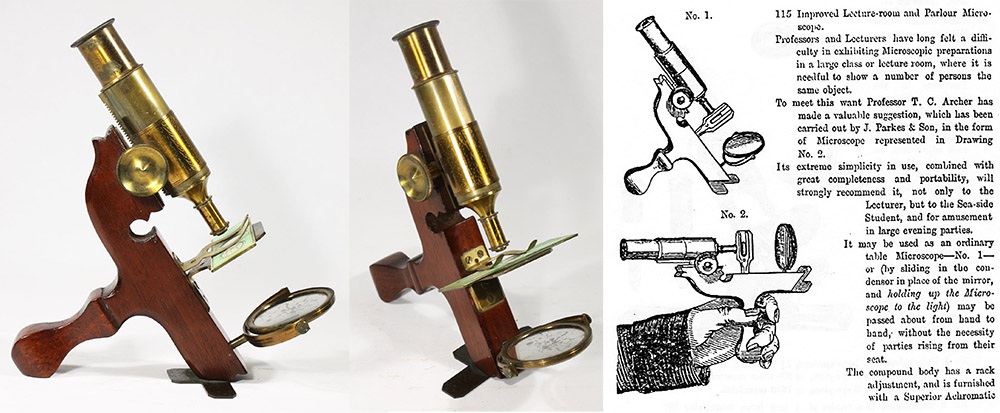
Figure 4B.
By 1862, Parkes and Son had introduced an advancement on their hand-held microscope, known as the "Improved Lecture-Room and Parlour Microscope" (it was not included in the 1857 catalogue). It featured rack-and-pinion focusing, an ergonomic handle, a means to rest the instrument on a surface, and both a mirror and biconvex lens for illumination. The image on the right is adapted from Parkes’ 1862 catalogue.
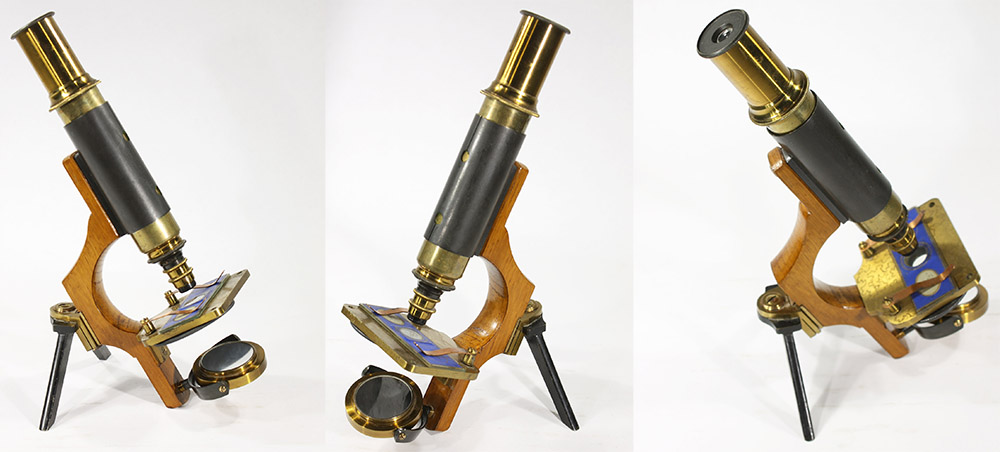
Figure 4C.
A later version of a "Lecture-Room and Parlour Microscope", by Parkes and Son. I have not identified it in any catalogues or advertisements. From the styling, I estimate that it was manufactured ca. 1880-1890. It is advanced, yet simpler, than the 1862 version, featuring an ergonomic handle, a means to rest the instrument on a surface (which can be removed by turning a screw), and a removable mirror.
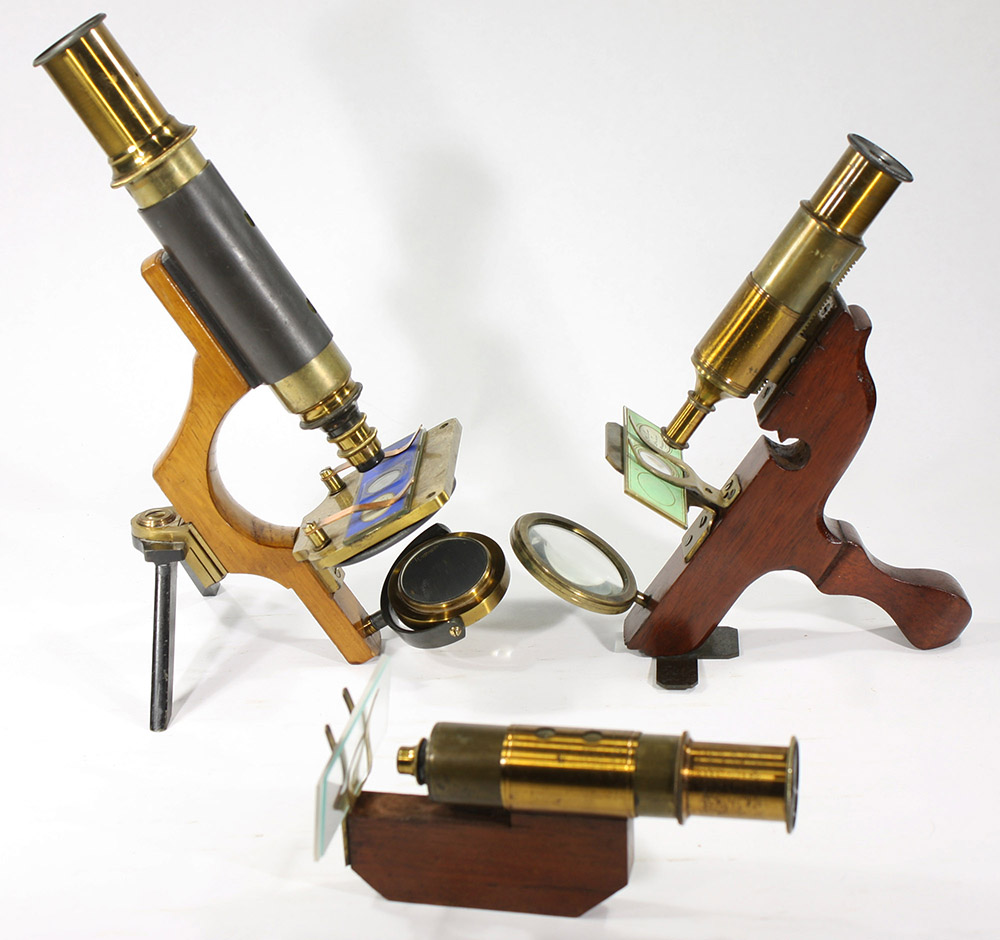
Figure 5.
The three hand-held microscopes known to have been manufactured by Parkes & Son.
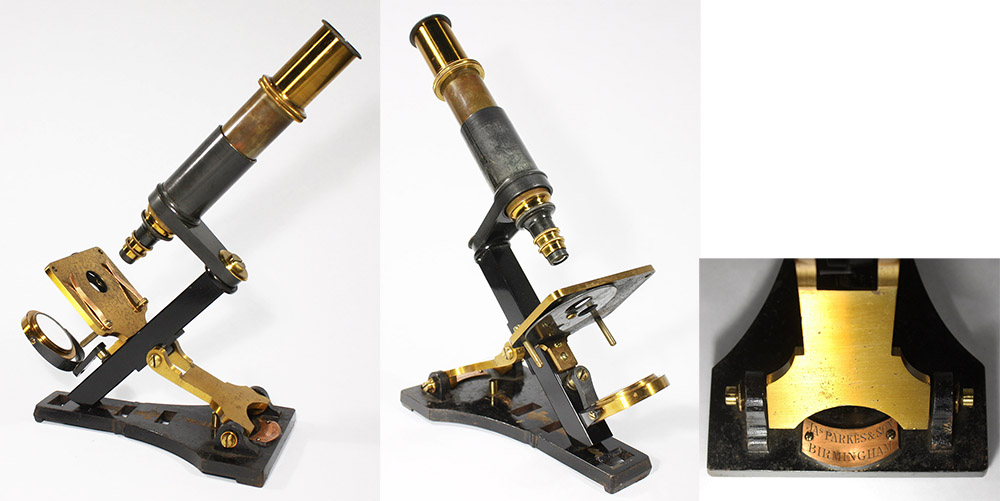
Figure 6.
A J. Parkes and Son compound microscope, probably ca. 1880. A hinge and wedge system facilitates use of the instrument at either of several angles, or folded flat for storage.
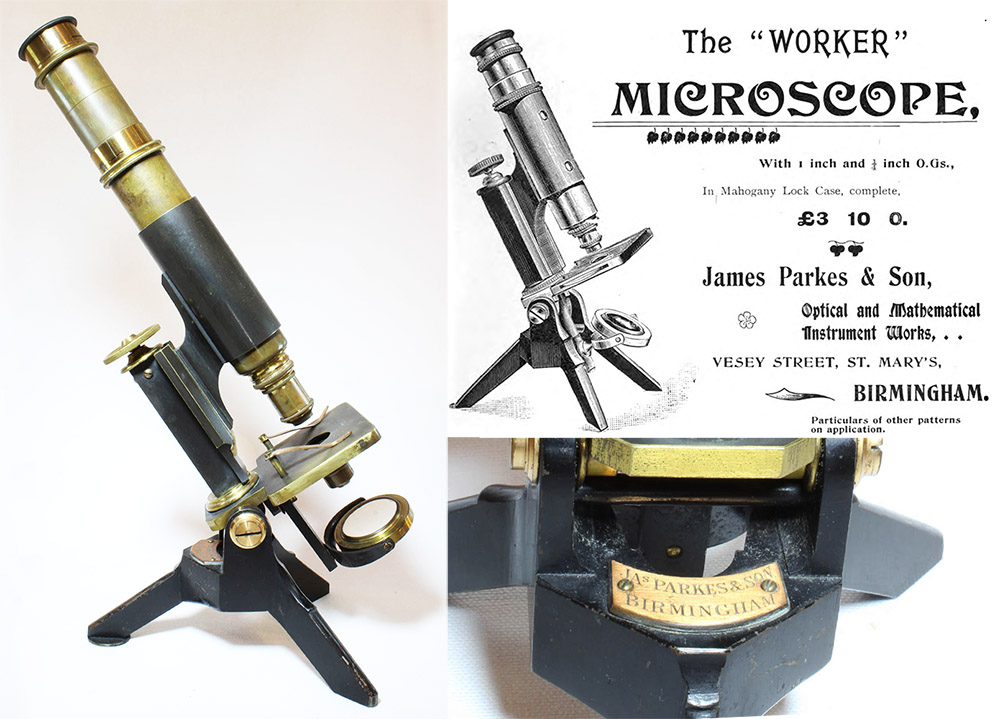
Figure 7.
The “Worker” microscope. The advertisement in the upper right is from the 1898 “Illustrated Annual of Microscopy”. This model was produced for many years into the twentieth century. Adapted with permission from http://www.microscope-antiques.com/parkes.html.
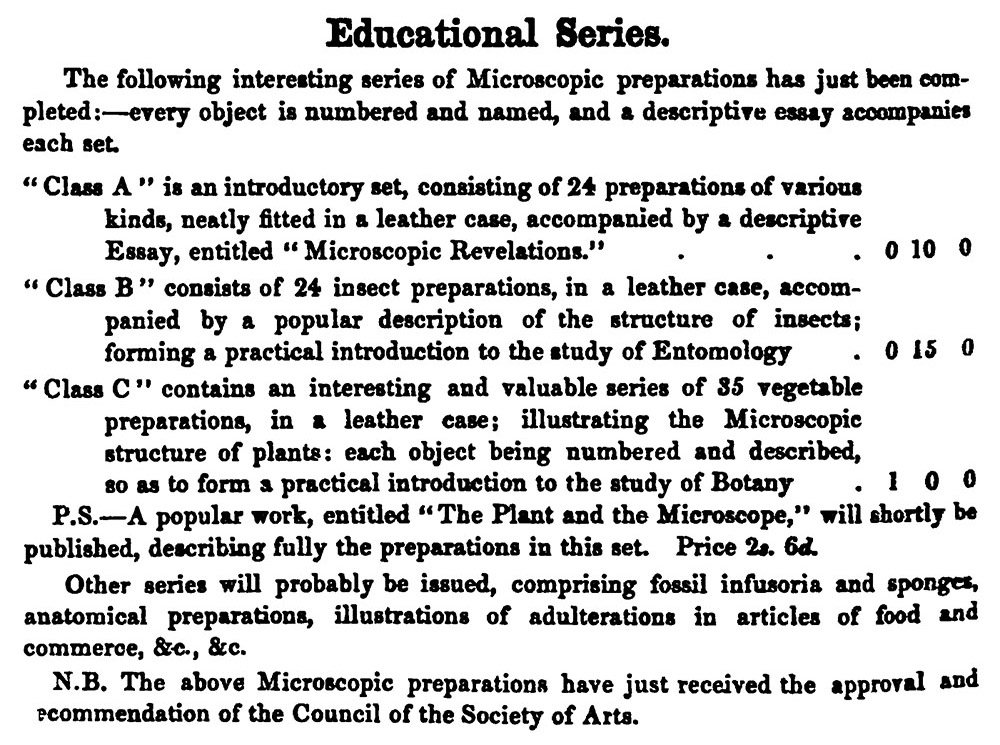
Figure 8.
Description of James Parkes and Son’s “Educational Series” of microscope slides, from their 1857 catalogue. Slides matching these descriptions are shown in Figures 9-11
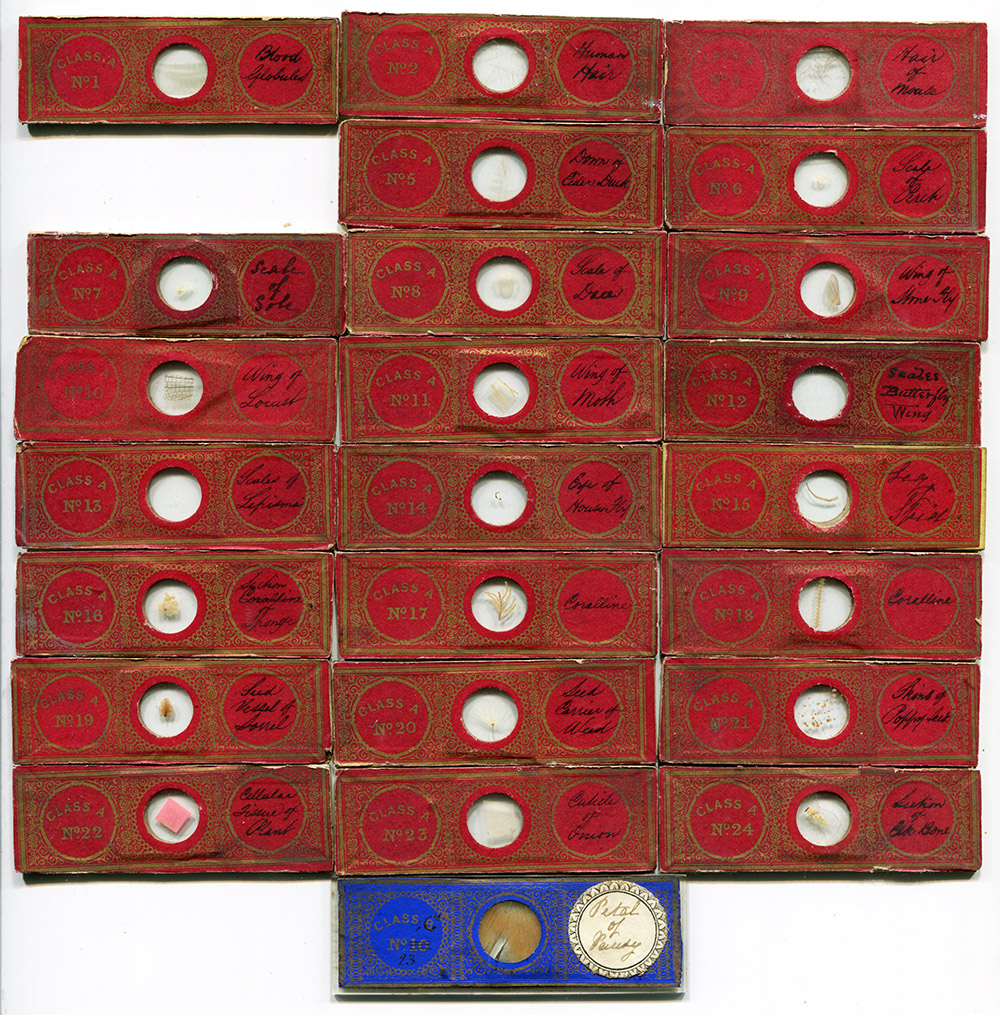
Figure 9.
In 1857, J. Parkes and Son offered a “Class A” set of microscope slides, “consisting of 24 preparations of various kinds”. The red-labeled slides are numbered and marked “Class A”. Known numbers only go as high as 24. The blue-colored paper on the lower slide has printing “Class B” and “10”. Parkes’ “Class B” slides were of insect specimens, whereas this is a petal from a pansy. Note that the “B” has been overwritten with a “C”, and the number crossed out and replaced with “23”. The pansy petal was number 23 of “Class C” (see Figure 10, below). The illustrated “Class A” slides are slightly smaller than the standard 1x3 inch blue-papered slide.
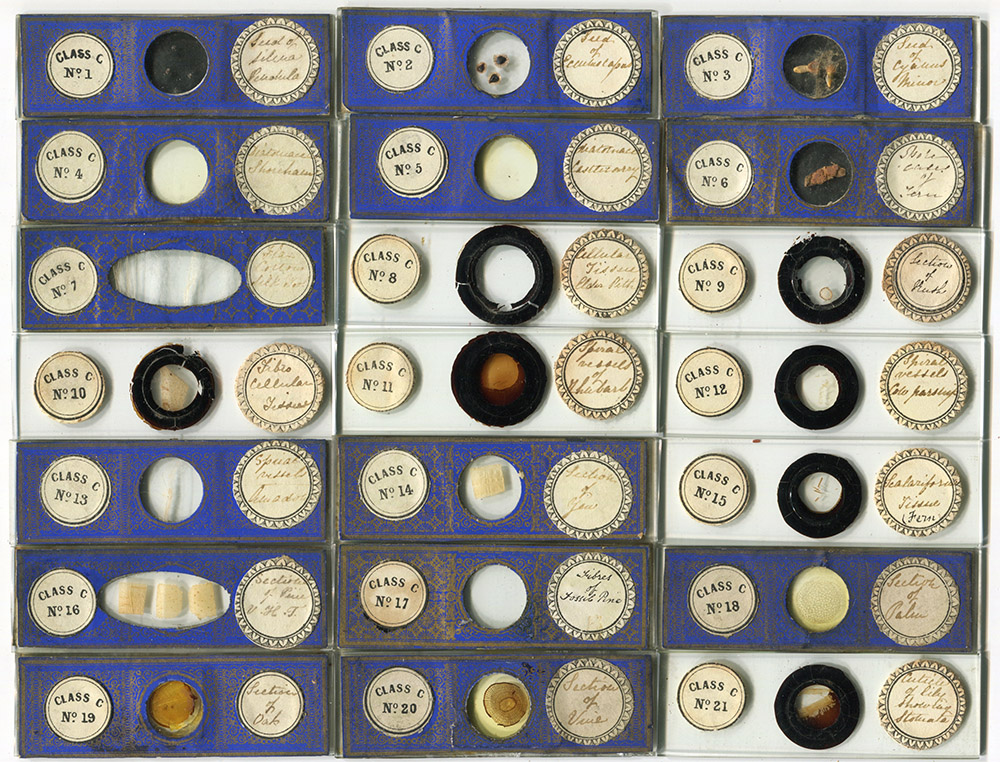
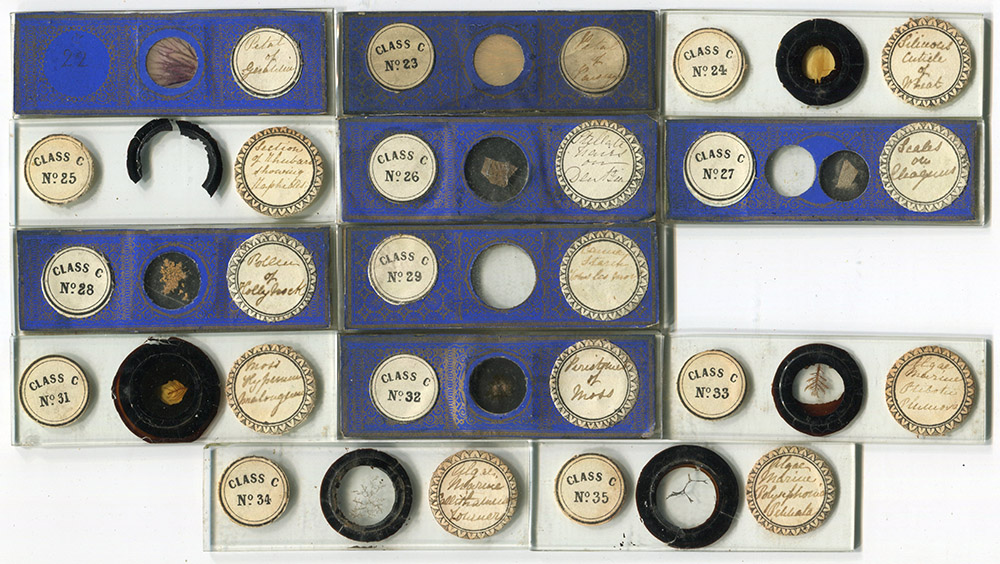
Figure 10A.
An almost-complete array of “Class C” slides, described as “35 vegetable preparations”. This is a mix of slides from sets that were likely produced over a span of several years, from a time when paper covers were fashionable to a later time when unpapered slides were preferred.
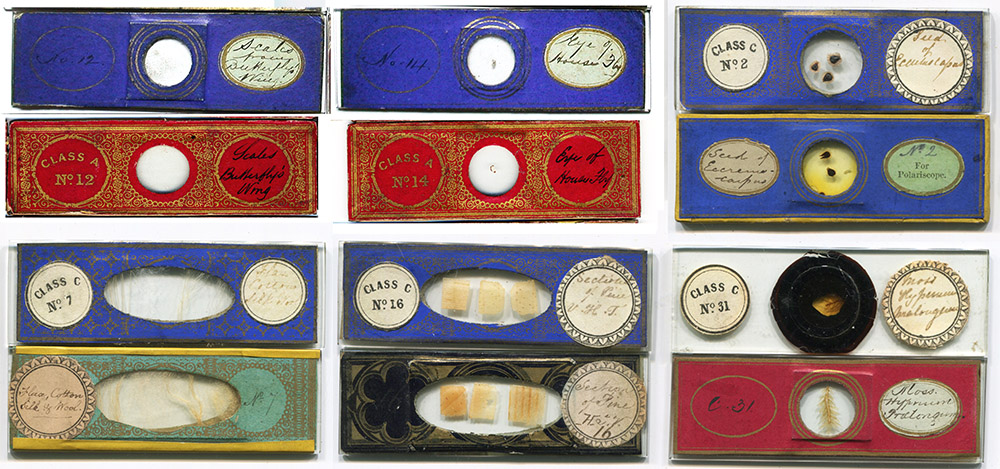
Figure 10B.
Labeled “Class A” and “C” slides, paired with slides of various styles that contain the same specimens and bear matching handwritten letters and numbers. These suggest that Parkes probably contracted with several different slide-makers over the years, some of whom used Parkes’ original printed papers, while others did not.
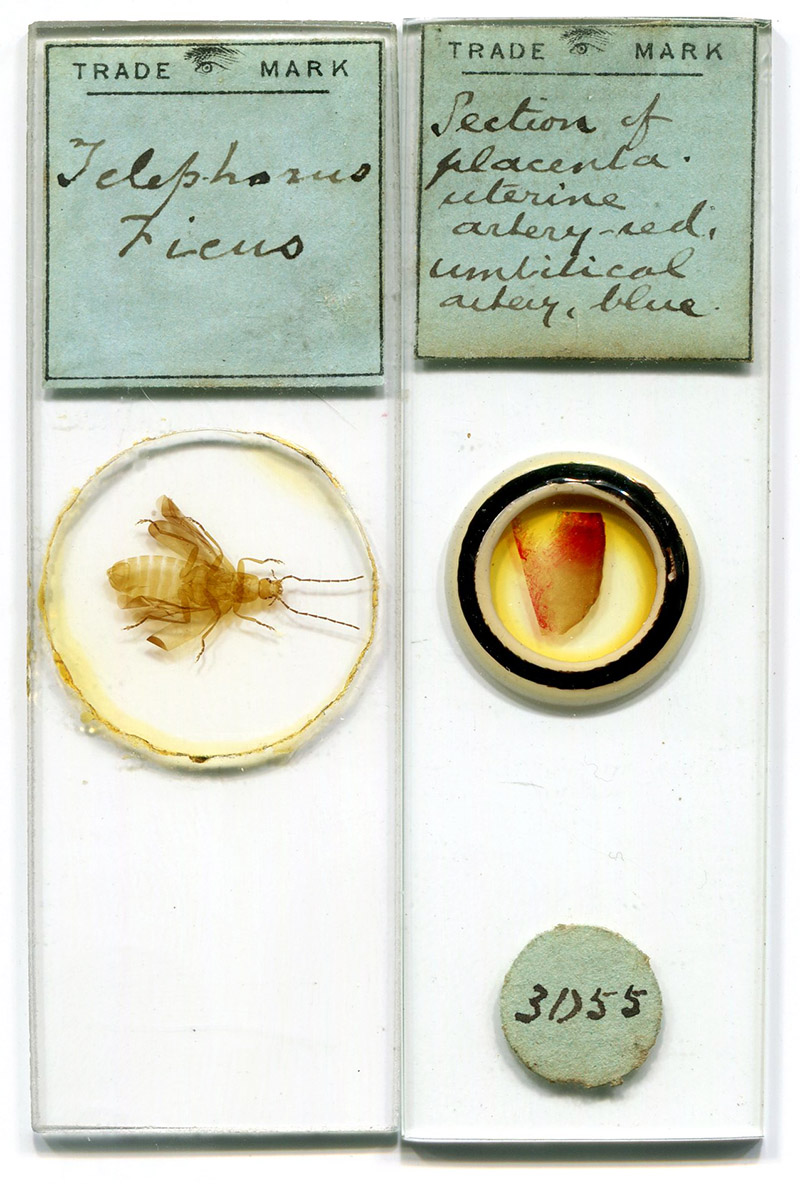
Figure 11.
Later microscope slides that were retailed by Parkes & Son, identified by their Eye and "trade mark".
The earliest record of James Parkes that can be firmly identified is of his May 1, 1816, marriage to Elizabeth Hickling, at St. Martin’s Church, Birmingham. The first child, Samuel Hickling Parkes, was born the following year, on April 8, 1817 (he would later become the “Son” of Parkes & Son). Samuel’s baptism record gives James’ occupation as “toy maker”, living on St. Mary’s Row.
An 1818 directory of Birmingham listed James’ occupation as “stamper and piercer” (i.e. he embossed and cut metal, evidently for the “gilt toys”). He was not listed in previous directories, implying that he formed his independent business around the time of his marriage. However, the 1815 Wrightson's Triennial Directory of Birmingham listed Susannah Parkes and Sons as “gilt toy makers” on Bath Street. Susannah was the widow of “toy maker” William Parkes. Their third known child (and second son) was named James Parkes, baptized at St. Martin’s Church on August 7, 1786. Our microscopist’s census and death records indicate that he was born in 1786. Susannah’s business, later known as S. Parkes & Son (note: only one son), was operated after her death by William Parkes (baptized December 26, 1787 at St. Martin’s Church). Taken together, we can be reasonably certain that microscope-maker James Parkes was born during the summer of 1786, son of William and Susannah.
Production of small metal items appears to have been Parkes’ main occupation for several decades. Directories from 1823, 1830, and 1833 all list his as “stamper and piercer”. An expansion into applied apparatus was indicated in the 1839 Wrightson's Triennial Directory of Birmingham, where he was listed as “gilt toy and compass maker”. One would use the same tools to produce compass cases and snuff boxes.
Samuel Hickling Parkes’ marriage to Emma Lloyd Kershaw, on September 4, 1845, listed his father’s occupation as “gilt toy manufacturer”. That marriage probably coincided with his becoming a partner with his father, as the independent income would allow him to afford a family. A patent was issued in 1846 to “James Parkes and Son, Birmingham”, for a “stock fastener” (a pin to hold a stock necktie in place). However, it is possible that this could have been another set of people, as there were several people named James Parkes in Birmingham at the time, including one who later produced bicycles and motorcycles. It is certain that our partnership had been formed by 1847, when a patent for an “illuminated night clock” was issued to “James Parkes & Son, of 5, St. Mary’s-row, Birmingham”.
Samuel H. Parkes developed a reputation as a scientist, becoming a member of the Linnean Society, the British Association and the Royal Astronomical Society. He was also a corresponding member of the Montreal (Canada) Natural History Society. His scientific writings included On the Early Development of Organs in Embryonic Life (1865), and Unfinished Worlds: A Study in Astronomy (1888). Samuel’s scientific interests were probably the driving force for Parkes and Son to expand their product line. As noted above, their 1848 catalogue, issued shortly after Samuel became a partner, included “measuring tapes, land chains, mathematical instruments, miners’ and mariners’ compasses, watch keys, seals, &c., &c.”.
James’ experience as a metal stamper and cutter also provided benefits to the partnership’s new directions. A review of their display at the 1862 London International Exposition stated, “J. Parkes and Son, Birmingham …, exhibit mathematical drawing instruments, distinguished by the following improvements: The joints are formed with plates of hard rolled steel and brass, cut by machinery to the required shape, and are therefore stronger, more accurate, and work more smoothly than the old cast joints. The blades of the drawing pens are pressed into the required shape, and being hollow on the inner side, retain the ink by capillary attraction; enabling the draughtsman to draw a fine or broad line with the same pen”.
In 1850, the partners were awarded a patent for a device for making rulers. Another, in 1853, to “James Parkes and Samuel Hickling Parkes, both of Birmingham, for improvements in the manufacture of certain drawing or mathematical instruments; also in packing or fitting the same in their cases; which said improvements in packing or fitting are also applicable to the packing or fitting of other articles”.
By the 1850s, J. Parkes and Son were producing a variety of microscopes. They were listed first in the 1857 and 1862 catalogues (Figures 12 and 13), indicating that such instruments were a major focus of the company. It is not clear whether they manufactured everything that they sold, but all were within the two men’s skillsets. Large numbers are known of later microscope models that were manufactured by Parkes but sold by other retailers (e.g. Figures 19 and 20). The 1871 census recorded that the Parkes and Son employed “14 men, 17 boys, and 7 girls”, a size sufficient to produce numerous microscopes and other apparatus.
They submitted entries to the Society of Arts’ 1855 competition for inexpensive simple and compound microscopes. Neither of Parkes’ entries was well regarded. They had learned of the contest less than a month before the deadline, though. Both awards went to rival Birmingham manufacturer Field and Son. Alison Morrison-Low has noted that Parkes continued to develop good-quality, inexpensive microscopes, which was the Society of Arts’ intention. Field, on the other hand, was constrained by the low prices set by the Society, and continually cut corners with their cheap microscopes to maximize profit. Field and Son instead turned their attention to producing other, more expensive microscopes, and photographic equipment.
Parkes and Son also retailed sets of microscope slides by 1857. Their A, B, and C sets of slides “received the approval and recommendation of the Council of the Society of Arts” (Figures 8-11). Maintaining their focus on the less-affluent customer, they offered “cheaply mounted objects for beginners, suitable for the smaller prize microscopes, are supplied at Is. per dozen”. In addition, “a discount upon these prices will be allowed to Members of the Society (of Arts), and to Institutions and Schools in Union”, and a London distributor was engaged. By 1862, Parkes was distributing slides from London makers such as John Norman (Figure 13).
A variety of “microscopes, astronomical telescopes, mathematical, philosophical, and surveying instruments” was displayed at the 1862 London International Exposition. The majority of their microscopes were inexpensive items, which were very well received. They did include, however, a ‘Fine Art Exhibition Microscope”, mounted on a base with mythical creatures and other designs (Figure 13). One reviewer wrote, “This firm has boldly attempted to develop a new point of union between art and science, in the production of a large “Fine Art" Microscope. As taste is proverbially not amenable to any known law, it is hoped that this “work of art” may not remain unappreciated; but an irresistible conviction arises that the body of a microscope mounted on the back of a dolphin, or a griffin, or anything of that sort, is an incongruous and uncommendable monstrosity”.
Patents were awarded in 1864 to “Samuel Hickling Parkes, of Birmingham, impts. in opera glasses, telescopes, microscopes, spectacles, and other optical instruments”. The omission of James implies that he had probably retired by that time. The 1871 census listed him as such, and living in Handsworth, Staffordshire. He died there, on January 17, 1877.
Samuel was the only son, and inherited the business. He retained the name J. Parkes and Son. Samuel and his wife, Emma, had only one child, Samuel Thomas Hickling Parkes, born February 16, 1856. The son would later inherit the business, along with a cousin, James E. Moulton. The 1871 census shows Moulton, then 27 years old, living with the Parkes family. They had a home in Kings Norton, on the outskirts of Birmingham, rather than living at the shop, and indication of their financial success. The family was served by two domestics. Both Samuel T.H. Parkes and James E. Moulton were listed in the 1881 census as “Optical Manfr Assistant”, and both lived with Samuel H. Parkes (Emma had died in 1877)
By 1879, the Parkes’ business address had spread to include both numbers 5 and 6 of St. Mary’s Row. Their range of manufactured items also increased. They were listed as “electrical instrument makers” in the 1883 Berly's British, American and Continental Electrical Directory and Advertiser. The firm moved to Vesey Street in 1893.
Parkes’ “Worker” microscope was introduced during the 1890s (Figure 7). It remained in production well into the twentieth century. Numerous examples are known with either no signature, or signed by other retailers (Figure 19 and 20).
An innovative microscope was exhibited in 1895, “Messrs. James Parkes & Son (Vesey Street, St. Mary's) sent an interesting universal stage microscope, intended for use by geologists, metallurgists, and petrologists, which was designed by Professor Lapworth in conjunction with themselves. It had a compound body with 4 inches of rack adjustment, and a large stage (7 inches by 7 inches) with universal pivotal motion for inclination to any required angle with the optical axis, with 2 inches of vertical and 4 inches of horizontal rack movement” (Figure 18).
Samuel T.H. Parkes married Beatrice Allport in 1895. They appear to have lived with father Samuel in Moseley, a suburb of Birmingham.
S.H. Parkes died on August 12, 1896. The English Mechanic and World of Science wrote, “The death is announced of Mr. Samuel Hickling Parkes, of Moseley. He was well known in scientific circles, for when only 21 Mr. Parkes had already begun to give lectures on natural history or literary subjects. His favourite study as a young man, and one in which he retained an interest through life, was entomology, and his lectures on this subject were very popular. Subsequently he took up the study of astronomy, on which he also lectured with great success. The substance of his lectures was imbodied about eight years ago in a book, “Unfinished Worlds,” of which a second edition was called for in three months. He was a life member of the British Association, whose meetings he regularly attended. He was one of the founders of the Birmingham Philosophical Society, and one of the earliest members of the Birmingham Natural History and Microscopical Society. His earnestness in entomological research, also, led to his being elected a member of the Linnean Society and a corresponding member of the Montreal Natural History Society, while the work of his later years was recognised by his election as a Fellow of the Royal Astronomical Society. He was a constant contributor of papers to the Transactions of the societies with which he was connected”. His colleagues in the Royal Astronomical Society wrote, “Samuel Hickling Parkes was born at Birmingham on 1817 April 8. He was the eldest son of Mr. James Parkes, of Handsworth, the founder of a firm of optical and mathematical instrument makers in St. Mary's Row, Birmingham, and joined his father in this business about the age of sixteen. He worked hard to develop this business, but always found time for scientific pursuits. He married Miss Emma Lloyd Kershaw, and they had one child, Mr. S.T.H. Parkes, who survives them. Mr. S.H. Parkes died on 1896 August 12. Among his papers was found the following note, which his son has kindly communicated to the secretaries. ‘A short obituary is always requested by the R.A.S. for insertion in their proceedings. If this must be, I wish it to be as brief as possible. No reference to early school days, &c, but simply spent a practical, uneventful life - early devotion to study of general science, especially natural history and comparative physiology. This pursued through life, while engaged in active business. Occasionally lecturing gratuitously on these subjects. Uniform endeavour to act under the influence of religious principles, and to employ talents and knowledge bestowed in useful ministrations to others. When unable to engage in active duties, wrote and published ‘Unfinished Worlds’. It does not seem possible to comply with the spirit of this note better than by quoting it verbatim, adding simply that Mr. Parkes lived from 1865 to 1885 at King's Norton, where he had an observatory and a 5-inch refractor telescope. This was disposed of about ten years ago, and his later scientific observations were confined to microscopy. He was elected a Fellow of this Society on 1882 January 13”.
The 1900 Illustrated Annual of Microscopy listed this and other models, “James Parkes & Son (Birmingham) successfully maintain their effort to produce an efficient student's microscope, of the type of their ‘Worker’ pattern, of simple but sound construction, having objectives of moderate aperture, with penetration flatness and definition requisite for botanical and elementary histological work. Attention has been given during the past year to the correction of the aberration. Among the more specialized instruments recently designed by this firm may be mentioned a Student's Petrological Microscope, designed to meet, in another department of elementary study, a want similar to that met by the ‘Worker’. Further improvements have been made in a Traversing Microscope, having compound body inclinable to any angle to the object, for examination under direct illumination of metallic surfaces, with equal facility whether in situ in the rough, or in prepared specimens. In their Graptological Microscope (the Lapworth - Parkes model) an aluminium alloy has been introduced, whereby lightness and portability have been obtained without sacrifice of rigidity and strength.”
Strasburger’s Handbook of Practical Botany (1900) also recommended Parkes’ microscopes: “James Parkes & Son, Vesey Street, Birmingham, manufacture a series of inexpensive students' microscopes of simple but sound construction, suited for elementary histological work. (The) ‘Worker’ Microscope, with body slung on a tripod foot, fine adjustment of hardened steel and gun metal, working in solid machine planed box, and coarse adjustment by sliding tube in cloth-lined collar, one eye-piece, 1 inch and 1/6 objectives, in mahogany case, £3 15s.; or the same with diagonal rackwork coarse adjustment, £4 10s. The ‘Century’ Microscope, with body slung on tripod foot, large stage, diagonal rackwork coarse and improved micrometer screw fine adjustment (this latter placed in a new position to ease strain upon it), one eye-piece, 2/3 and 1/6 objectives, in case, £5 10s. Accessories are: Swinging substage, with screw adjustment, £1; ‘Abbe’ condenser, with iris diaphragm, £1”.
Samuel T.H. Parkes and James Moulton dissolved their partnership on June 5, 1908. Parkes retained the business. The 1911 census shows Samuel and Beatrice (with a domestic servant) in Northfield, Worcestershire, and he was a “Scientific Instrument Manufacturer”. Thomas lived in Balsall Heath, Worcestershire, described as “Manuf. Optician, temporarily out of business”.
A 1914 “Who’s Who in Business” described James Parkes and Son as “Equipped with modern appliances. Factory and offices cover about 530 square yards. Specialities: Various Scientific Apparatus, including Astronomical Telescopes, Microscopes, Magnetic Compasses and Sundials, Mathematical Instruments of all Grades, including School Drawing Compasses, Drawing Pins, and Scales. Patents: Various improvements in Mathematical Instruments, Microscopes, Binocular Glasses, and Reading Lamps”.
The duration of James Parkes and Son is not known to me. Samuel T.H. Parkes died on December 2, 1939. James Moulton had died on January 3, 1924.
Figure 12 (below).
Microscopes included in J. Parkes and Son’s 1857 catalogue.
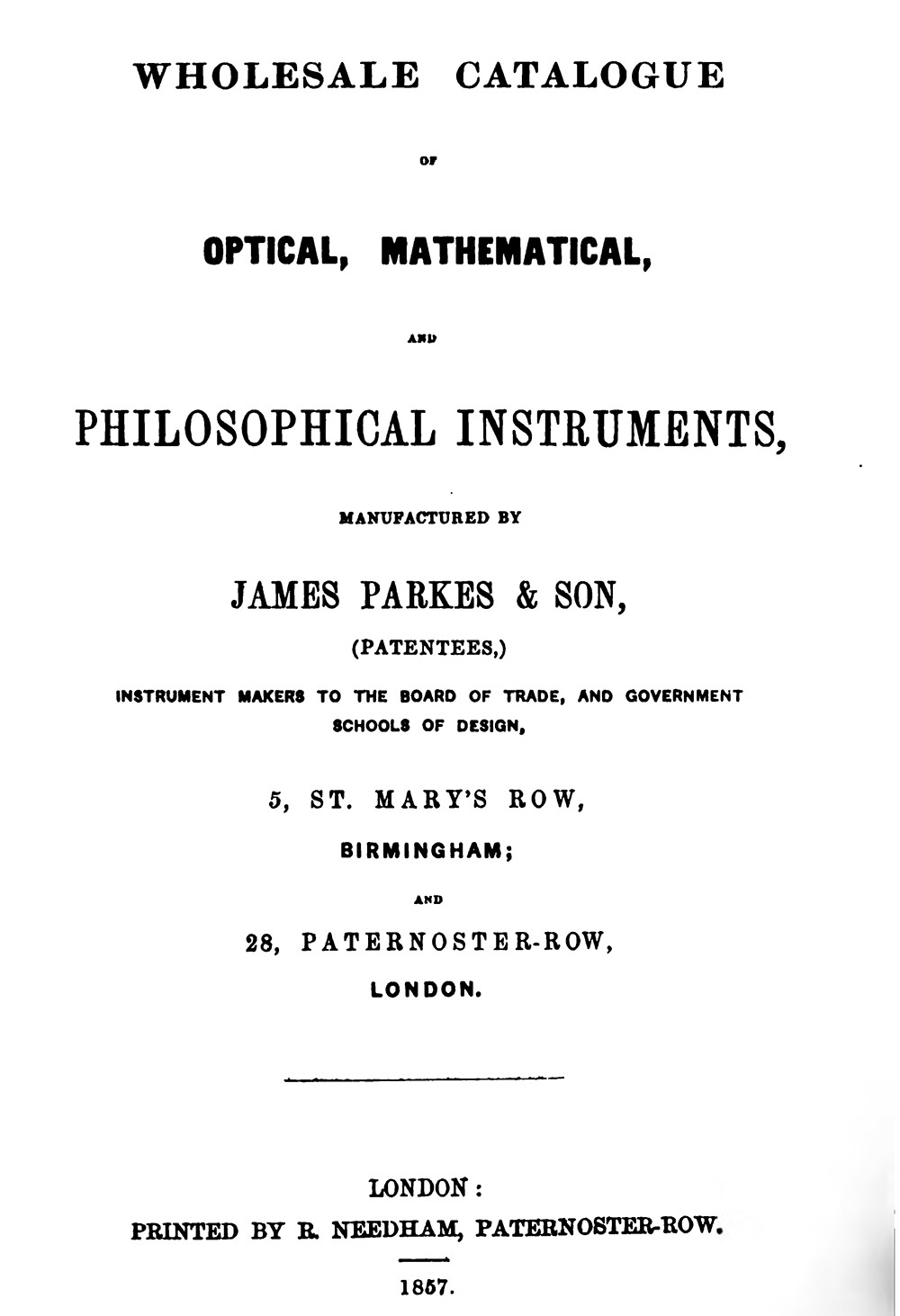
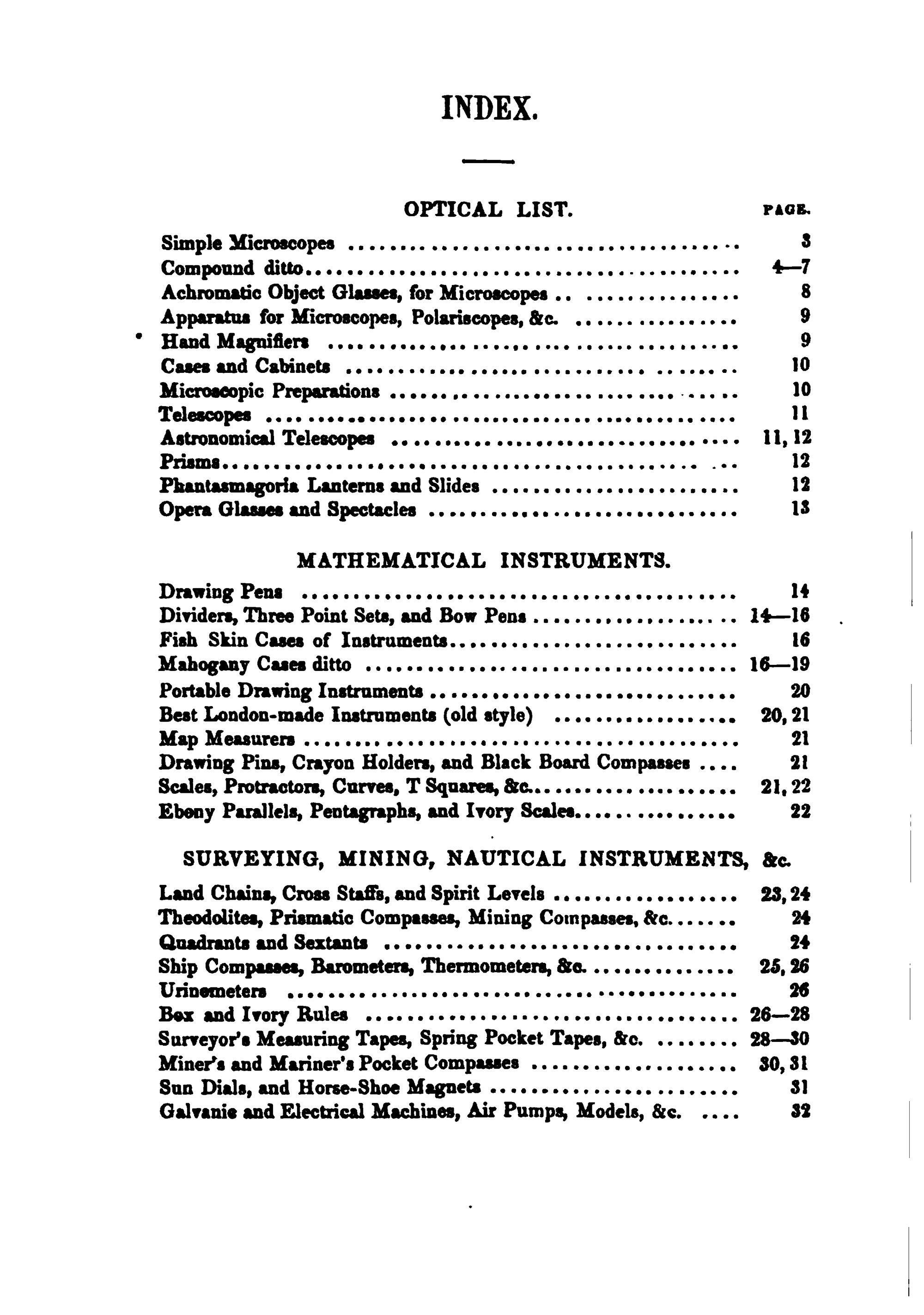
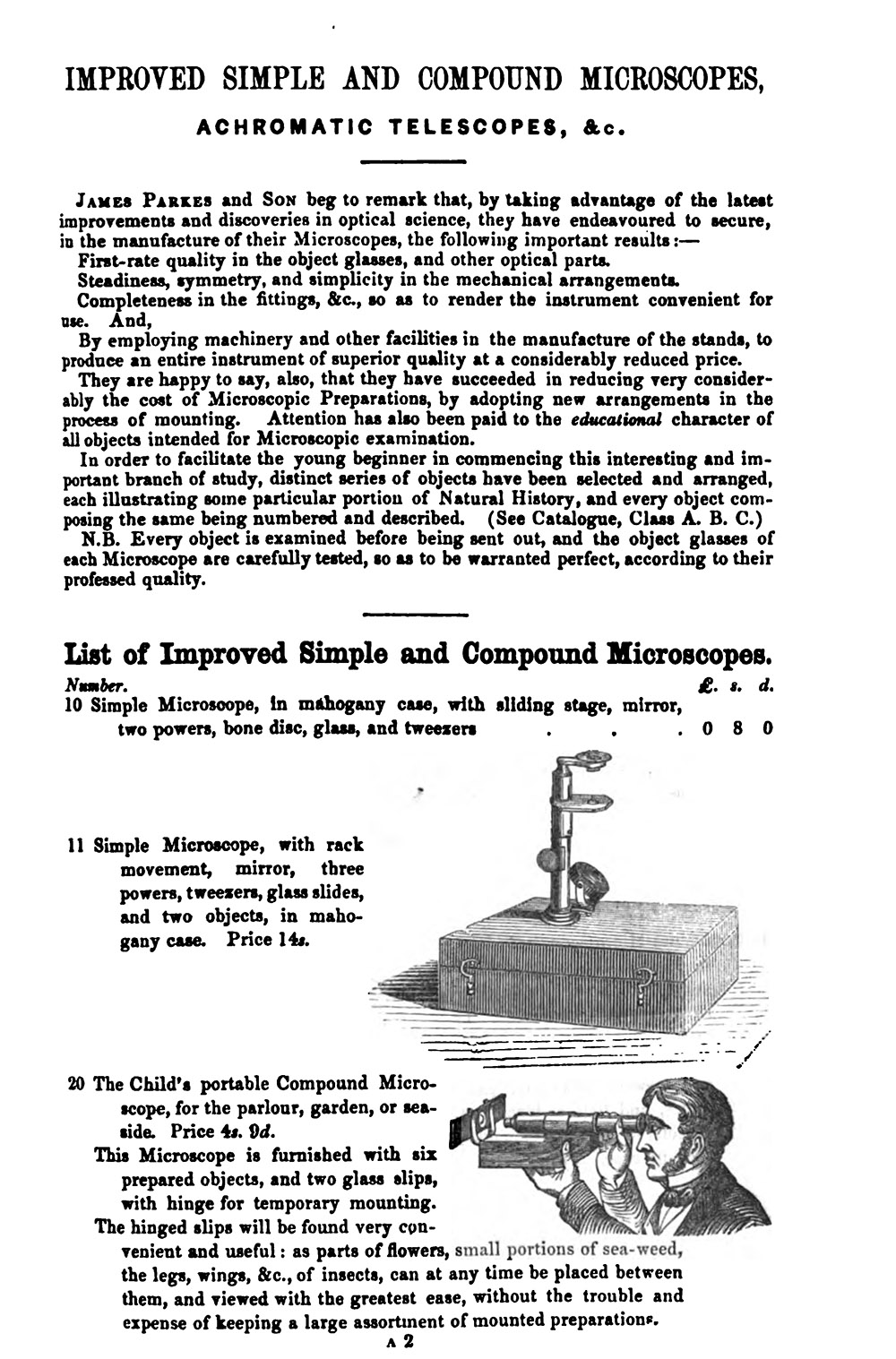

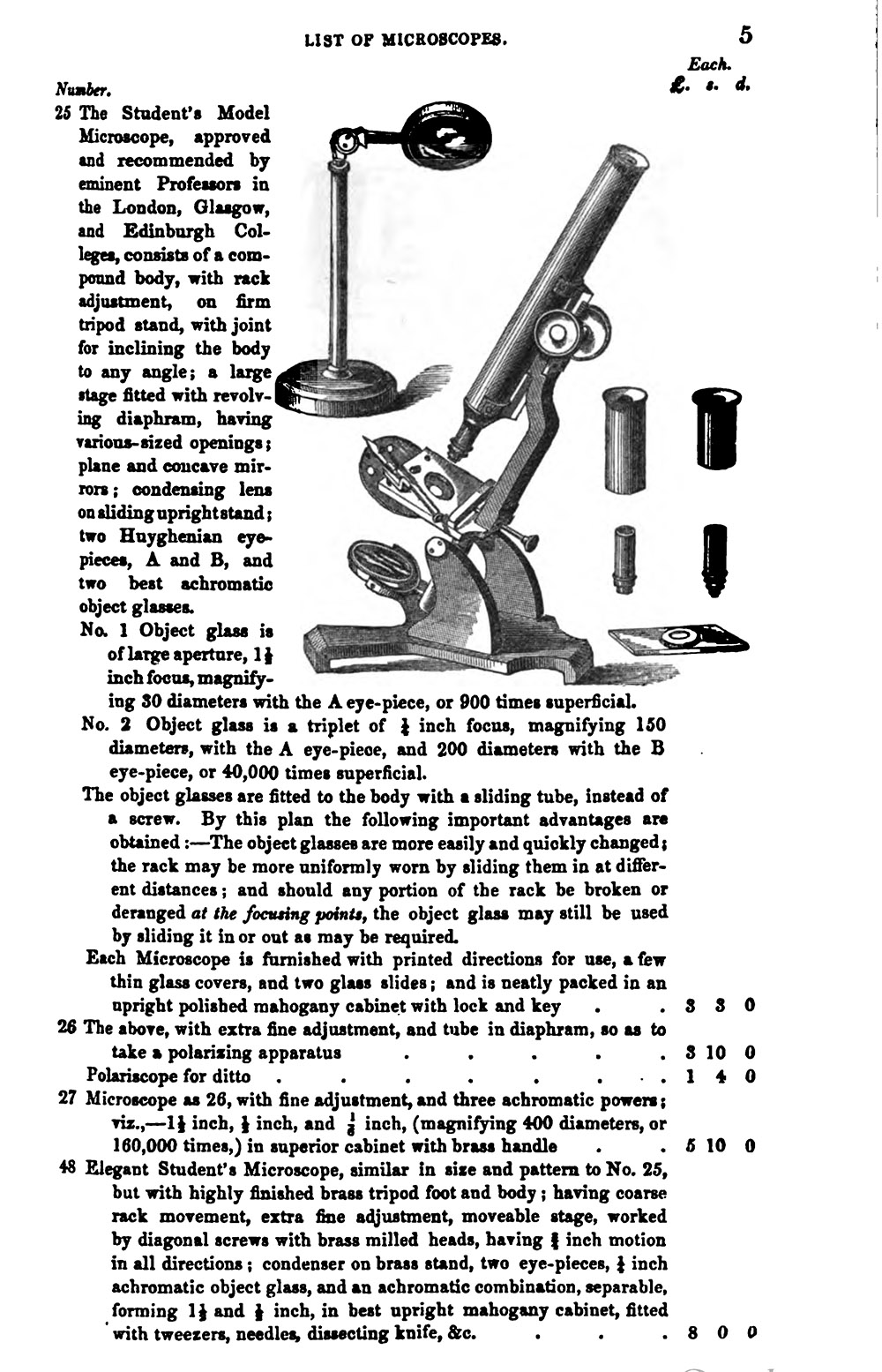

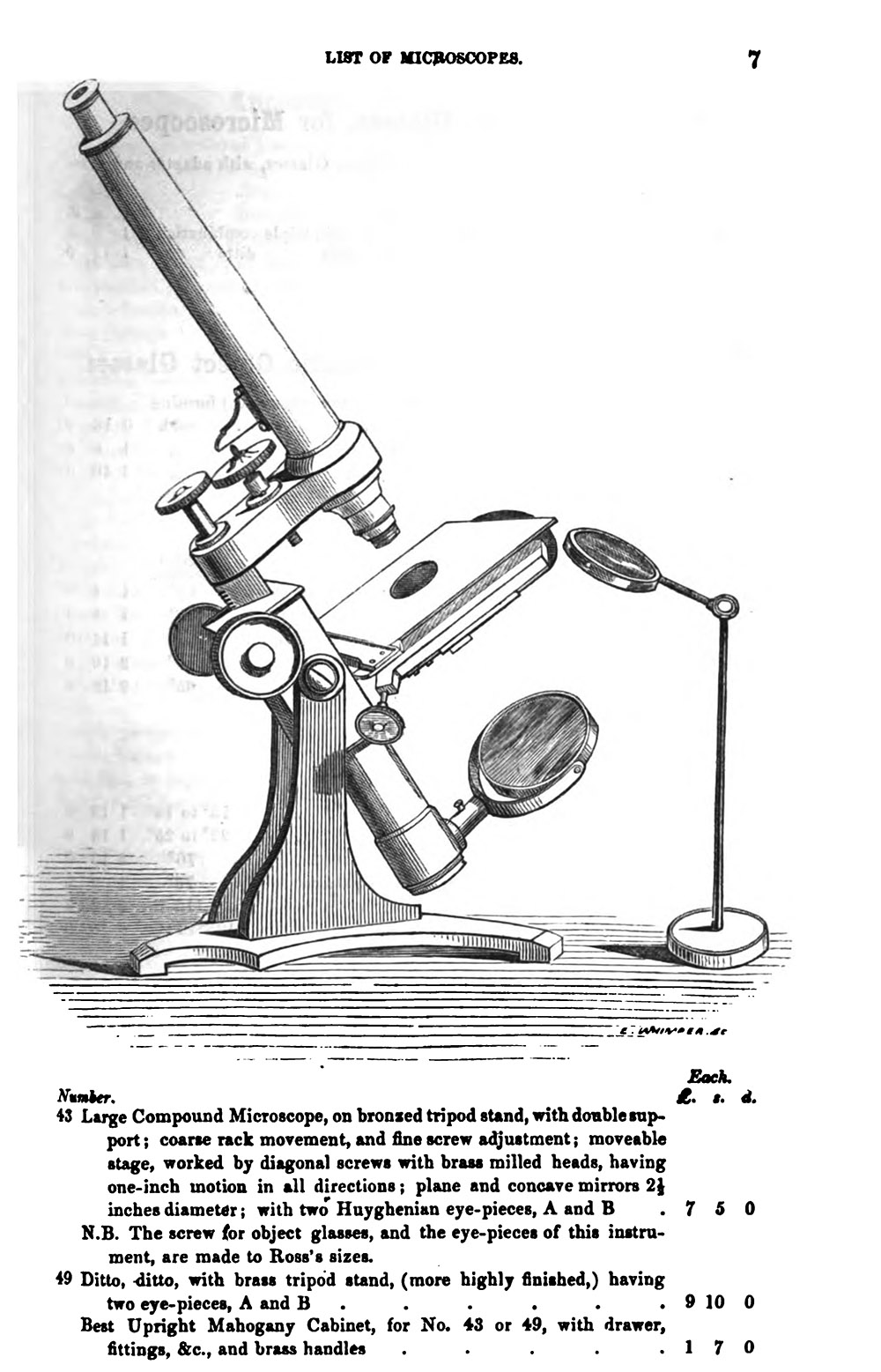


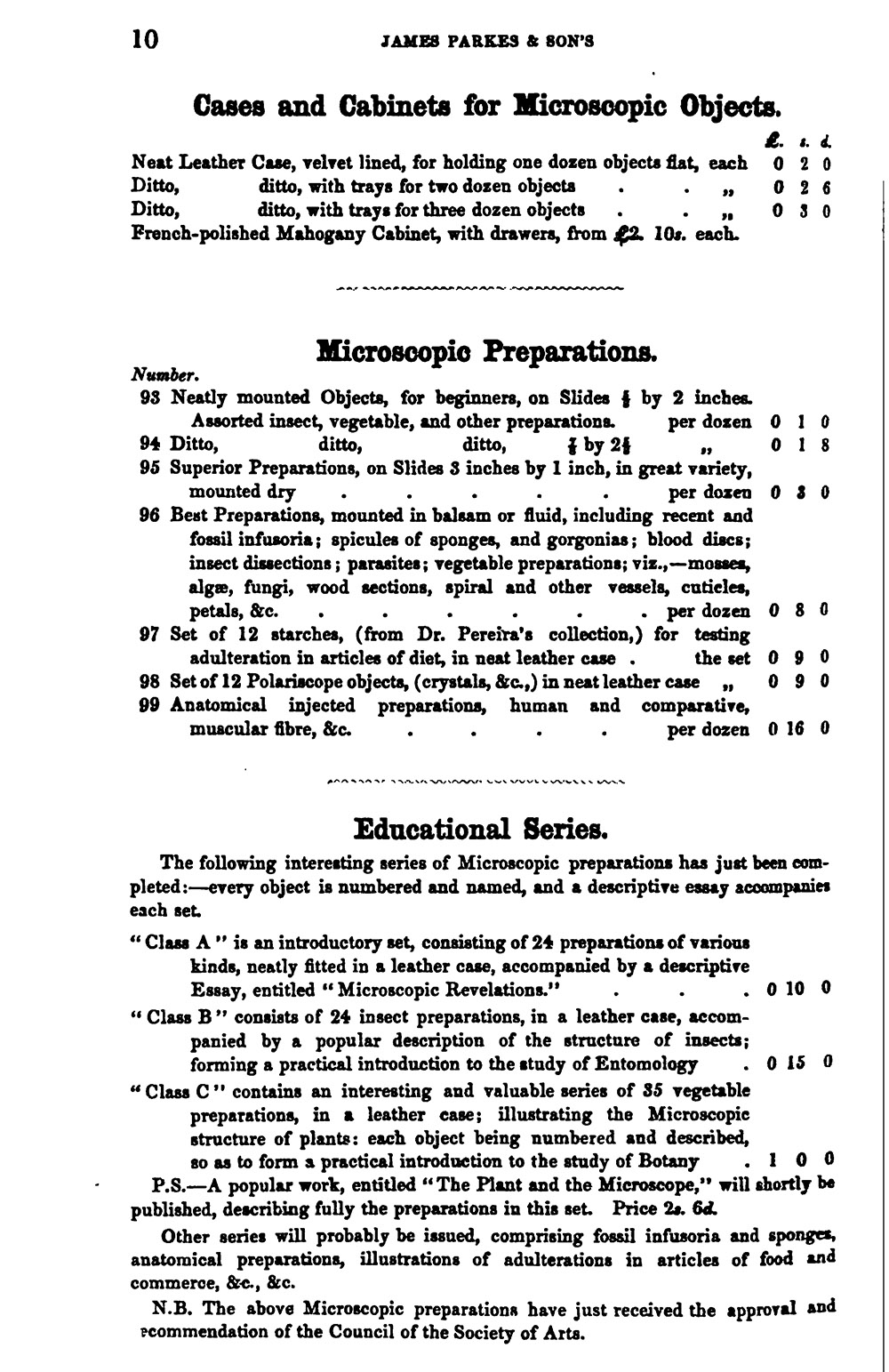
Figure 12.
Microscopes included in J. Parkes and Son’s 1857 catalogue.
Figure 13 (below).
Microscopes included in J. Parkes and Son’s 1862 catalogue.
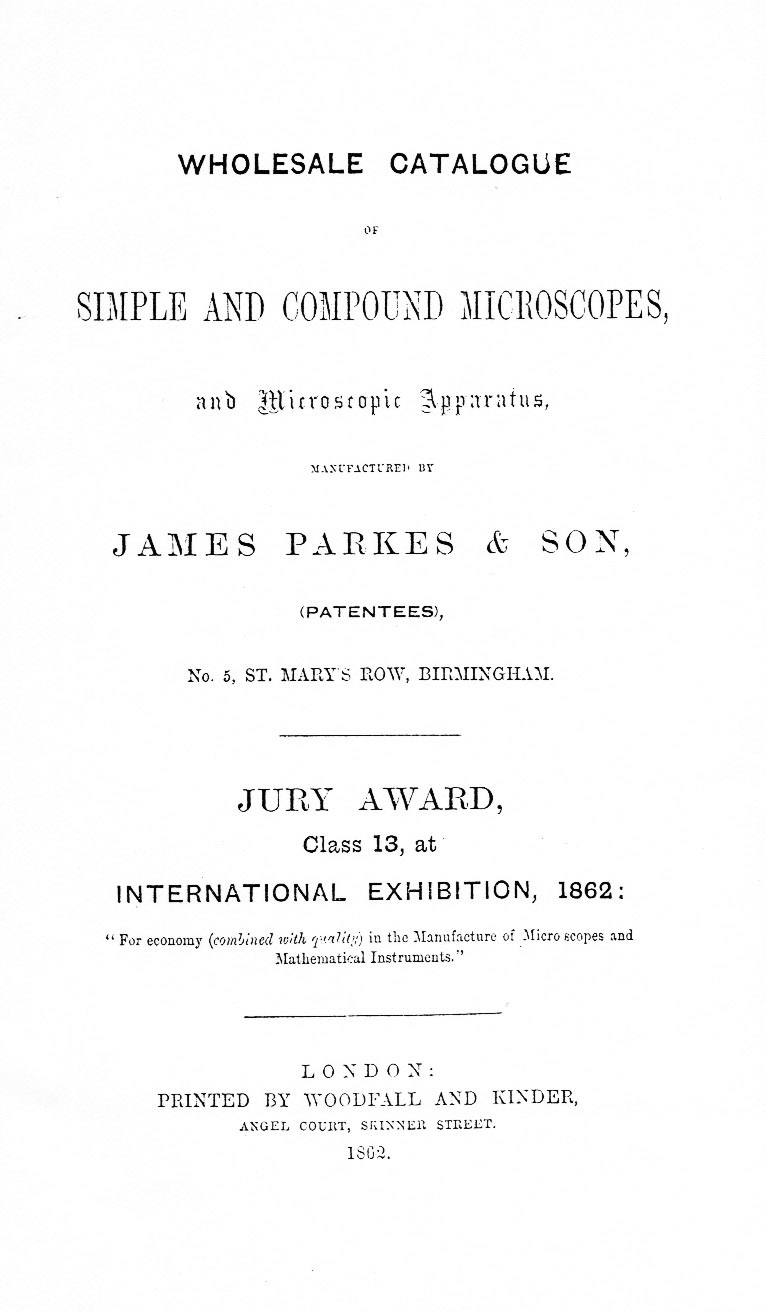

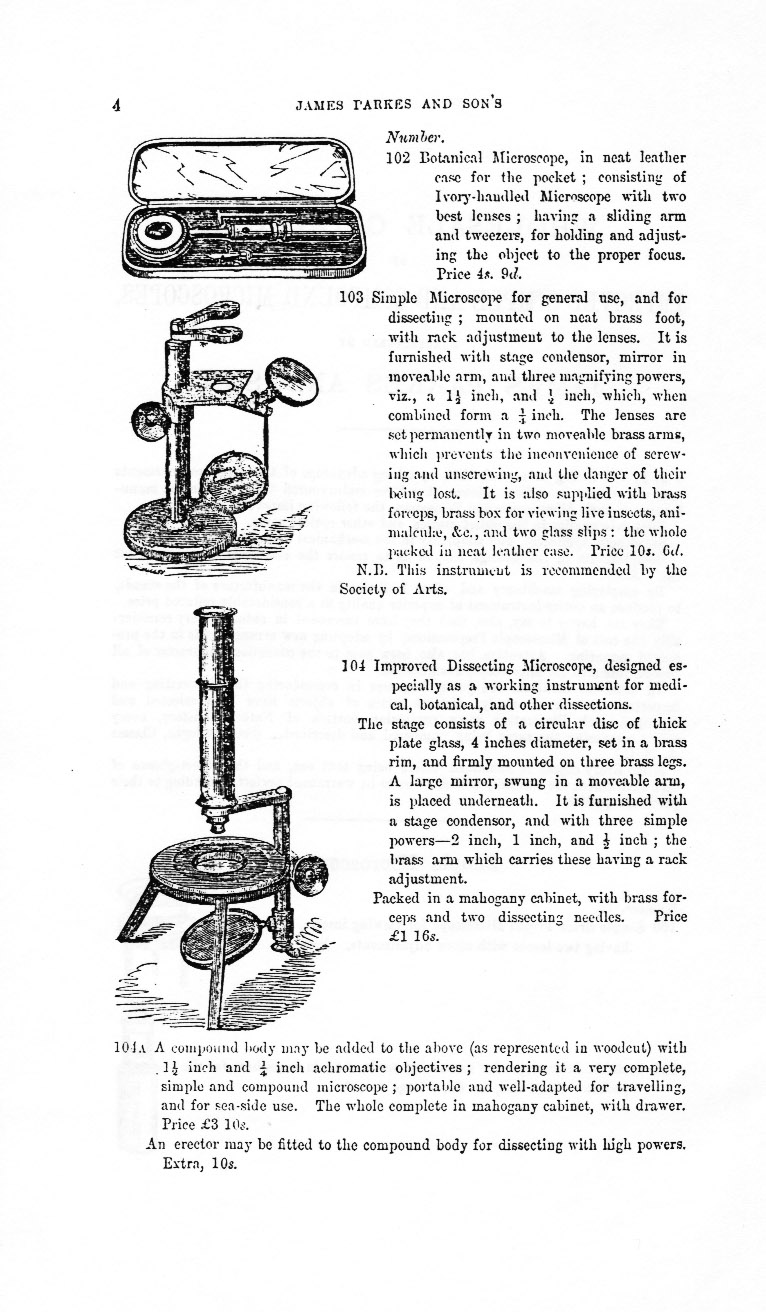
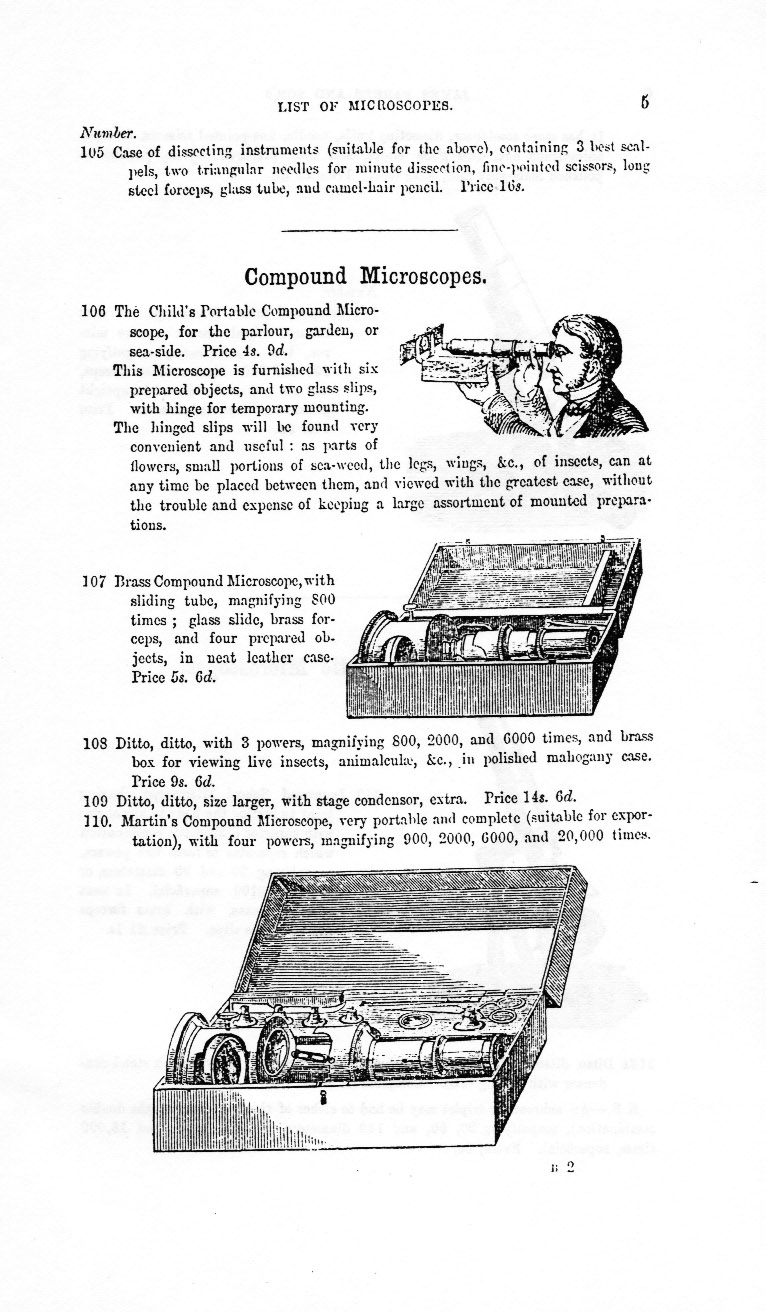
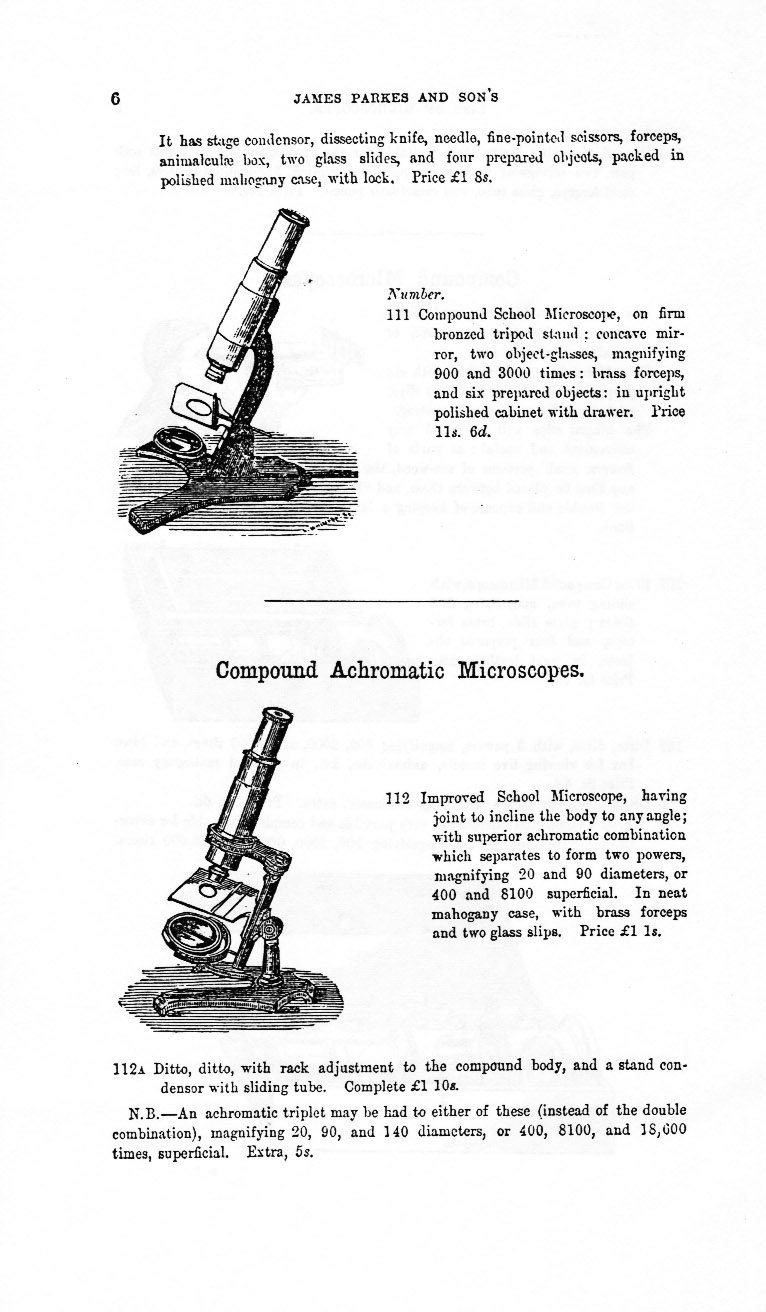

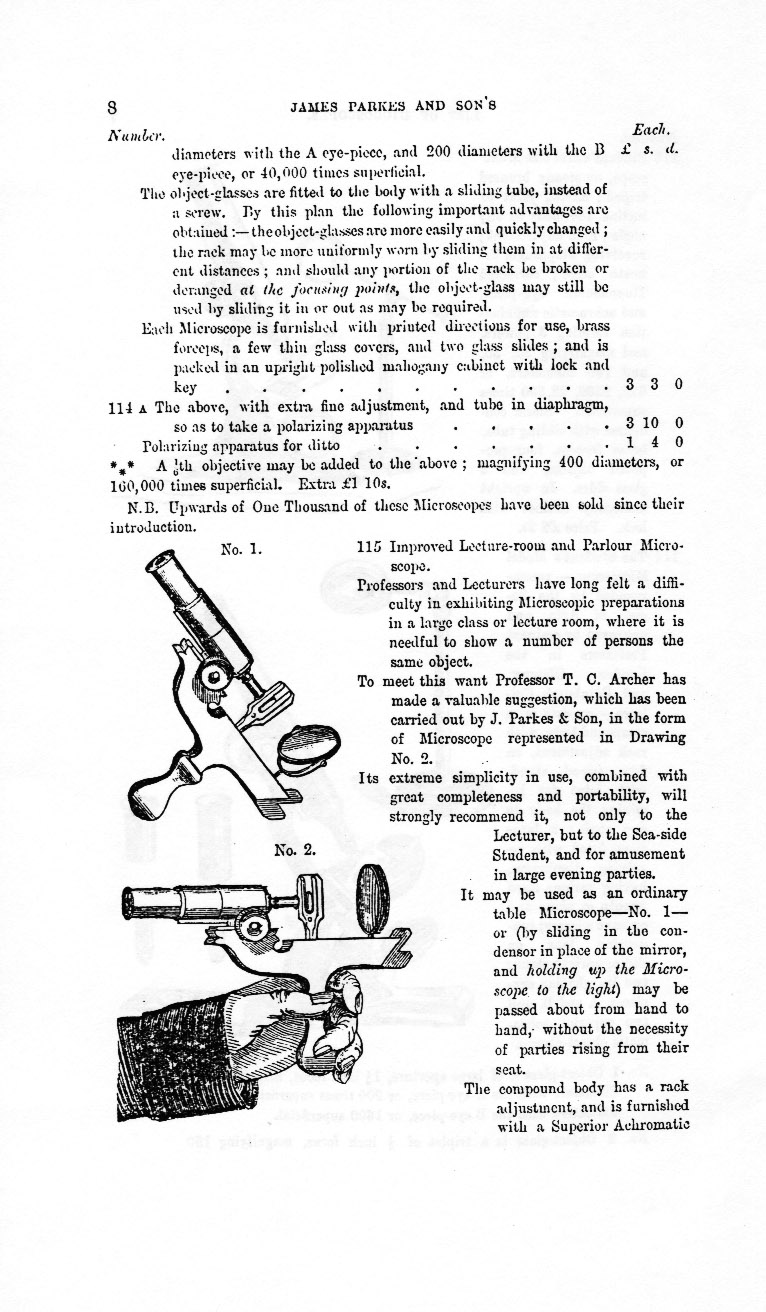

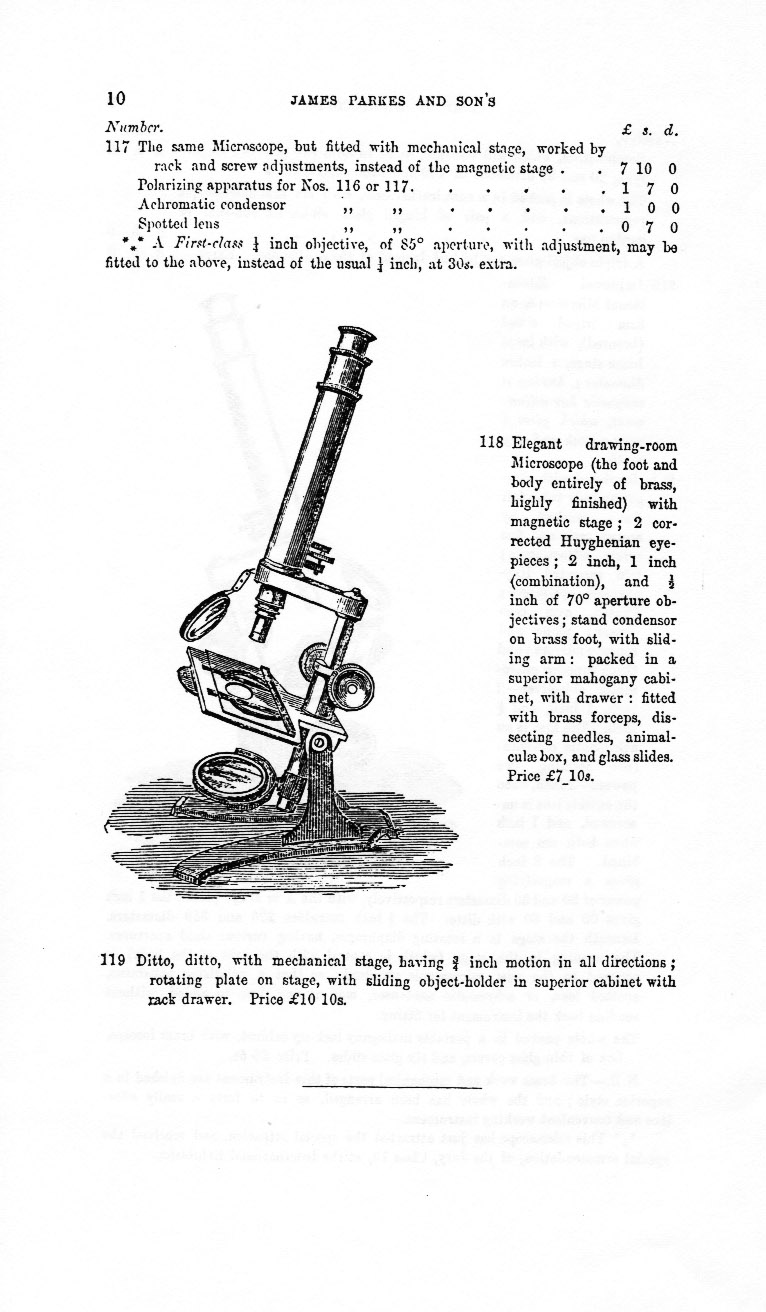
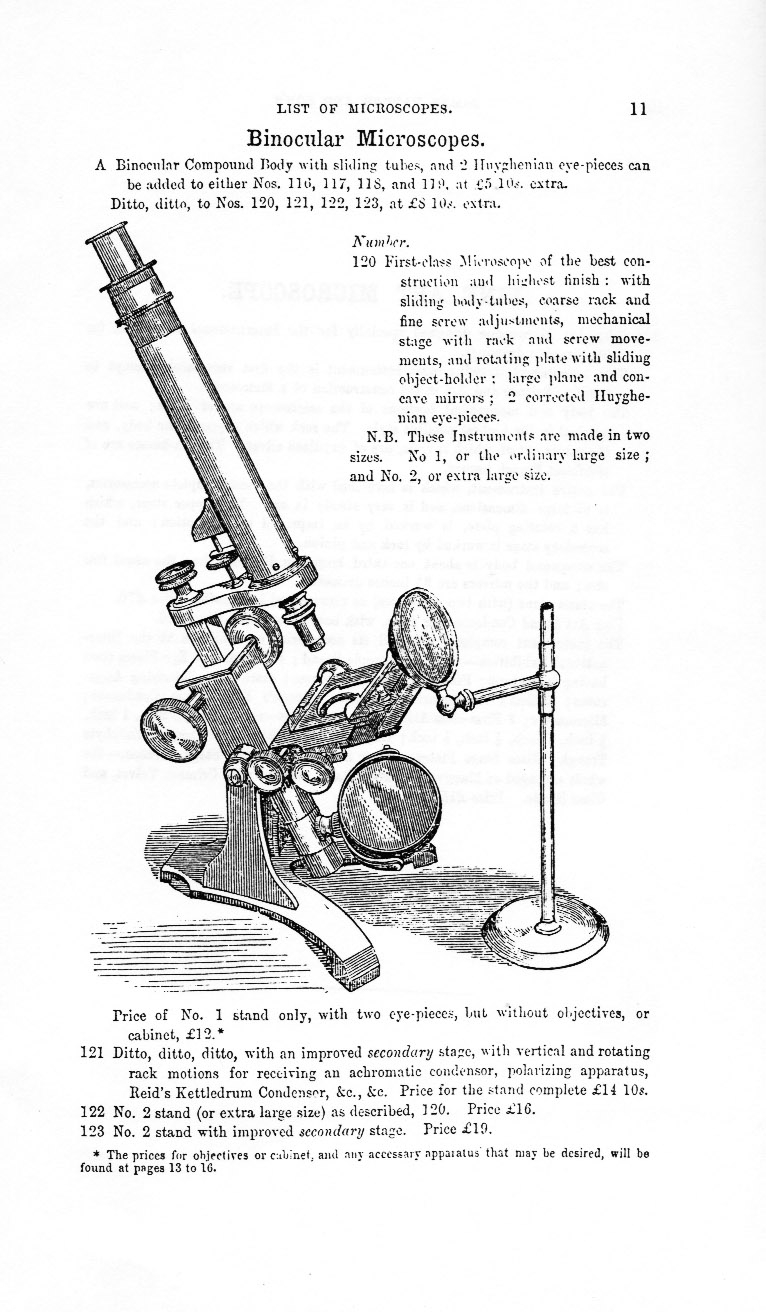
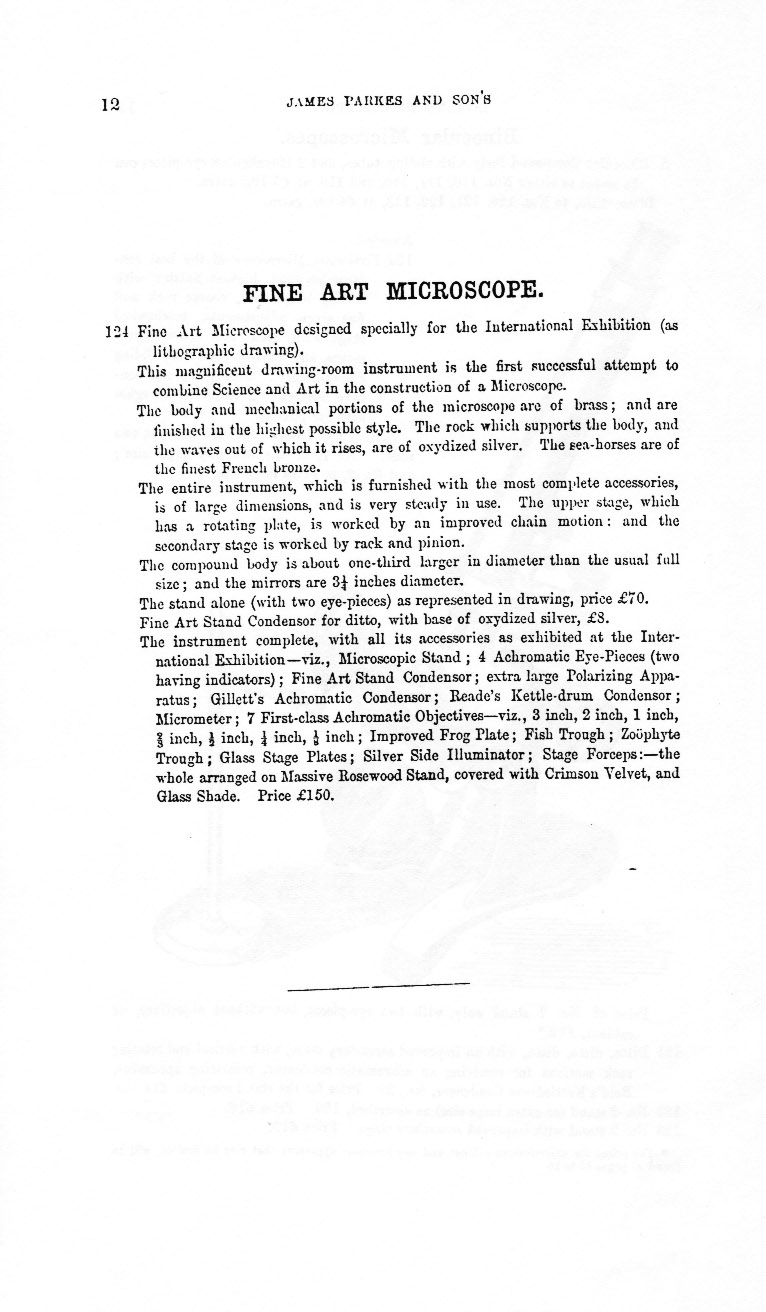
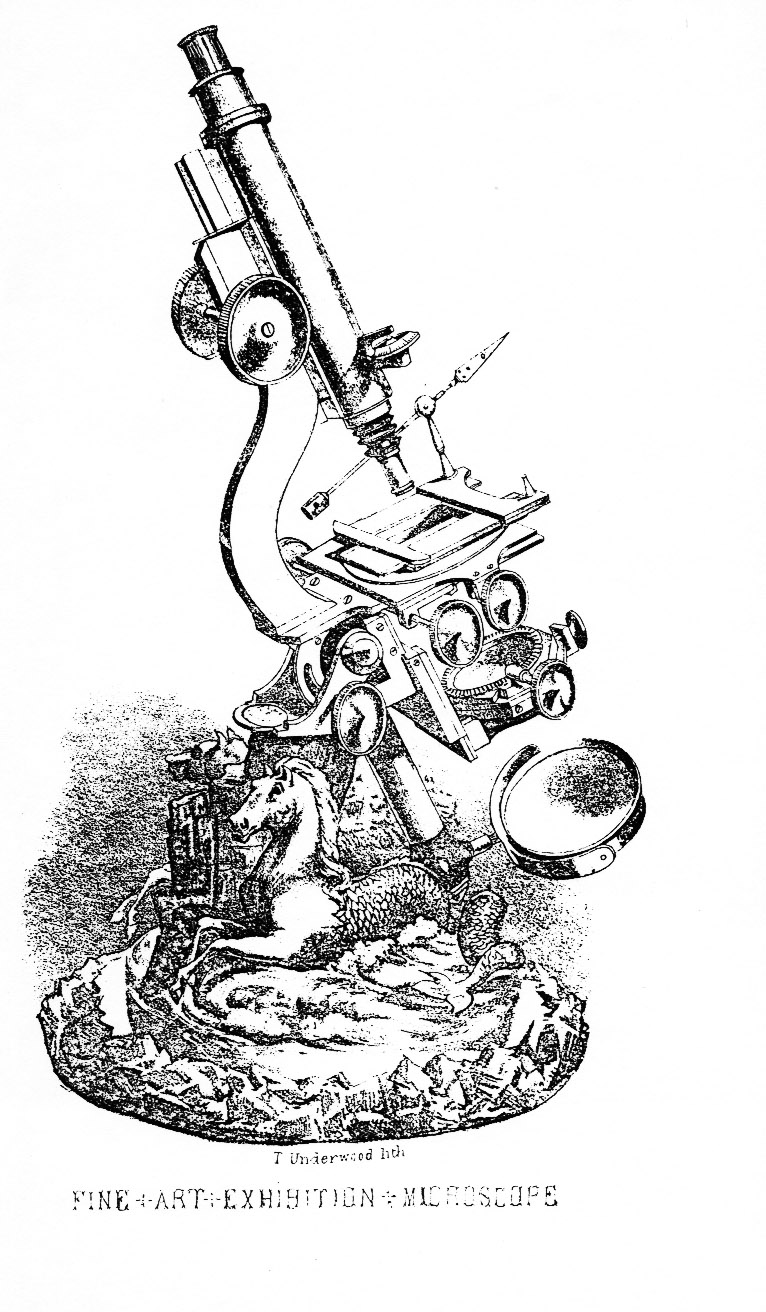
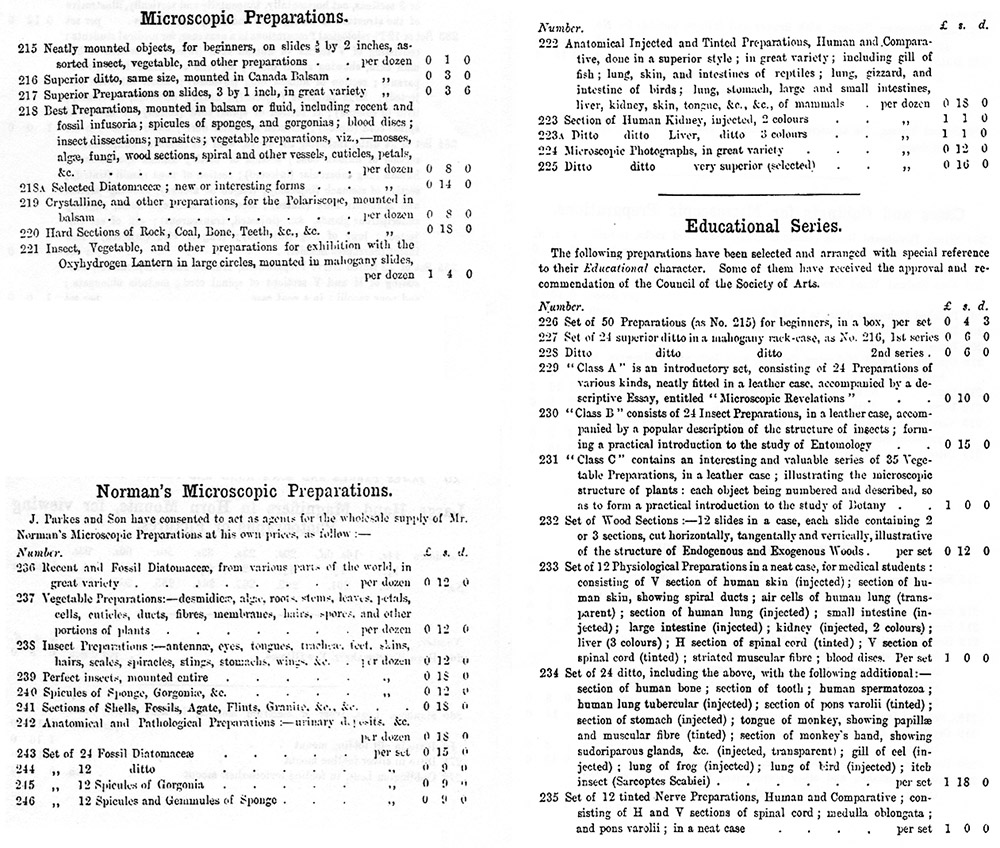
Figure 13.
Microscopes included in J. Parkes and Son’s 1862 catalogue. Adapted from http://www.microscopy-uk.org.uk/Little-Imp/index.html.

Figure 14.
Illustrations and descriptions of J. Parkes and Son’s entries in the 1862 London International Exhibition.
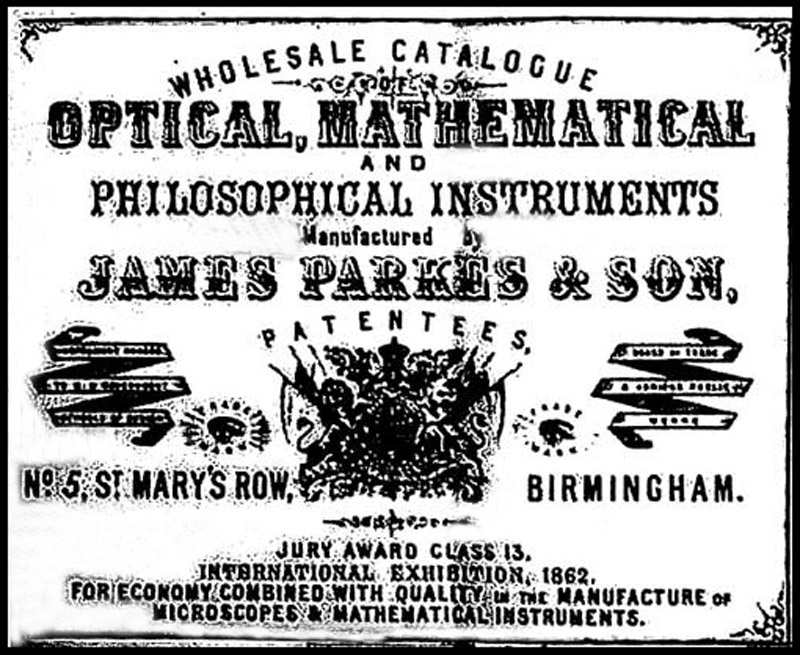
Figure 15.
Cover from the 1867 J. Parkes and Son catalogue.

Figure 16.
1881 advertisement from “The Journal of the Royal Microscopical Society”.
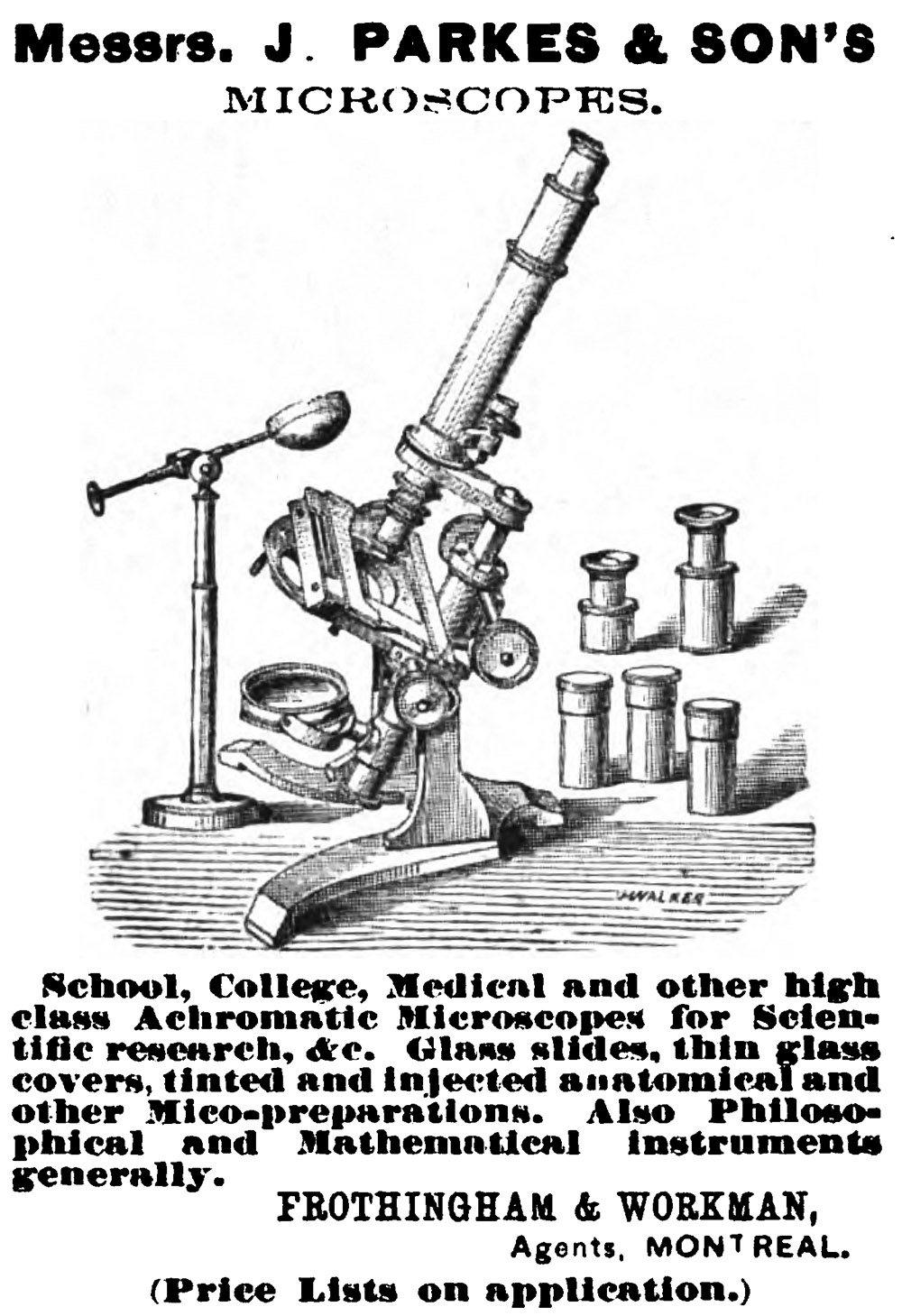
Figure 17.
1882 advertisement from “The Canadian Sportsman and Naturalist”.

Figure 18.
Parkes and Son’s “Lapworth” microscope. Adapted from Elles and Wood, “A Monograph of British Graptolites”, 1901.

Figure 19.
A 1914 advertisement from a Newcastle optical shop, featuring a Parkes and Son “Worker” microscope. A substantial number of these and other Parkes’ microscopes were sold under other retailers’ names.

Figure 20.
A Parkes and Son “Worker” microscope, engraved with the name of an Edinburgh retailer. Parkes put their “eye” trademark on the microscope, but otherwise left it unadorned. Adapted for nonprofit, educational purposes from an internet auction site.
Acknowledgments
Thank you to Steve Gill for providing access to the 1862 James Parkes and Son Catalogue, and many other historical documents through http://www.microscopy-uk.org.uk/Little-Imp/index.html, and to the developer of http://www.microscope-antiques.com for sharing microscope images.
Resources
Baptism record of James Parkes (1786) August 7, Parish records of St. Martin Birmingham, accessed through ancestry.com
Baptism record of William Edward Parkes (1787) December 26, Parish records of St. Martin Birmingham, accessed through ancestry.com
Baptism record of Samuel Hickling Parkes (1817) June 18, with note of April 8 birth, Parish records of St. Martin Birmingham, accessed through ancestry.com
Baptism record of Samuel Thomas Hickling Parkes (1856) August 30, with note of February 29 birth, Parish records of St Silas Lozells, accessed through ancestry.com
J.A. Berly's British, American and Continental Electrical Directory and Advertiser (1883) page 240
Birmingham 120 Years Ago (1896) “Parkes, Wm Toy-maker, 10, Wood-street”
Birmingham: History and General Directory of the Borough of Birmingham (1849) Francis White & Co., page 226
Bolton, Thomas (1882) Letter to the Editor, The Journal of Microscopy and Natural Science, Vol. 1, page 52
Bracegirdle, Brian (1998) Microscopical Mounts and Mounters, Quekett Microscopical Club, London, page 74
Burial record of Susannah Parkes (1830) April 2, Parish records of St. Mary Birmingham, accessed through ancestry.com
Canadian Sportsman and Naturalist (1882) Advertisement from James Parkes and Son, Vol. 2, January issue, back pages
Carpenter, William B. (1883) Parkes’ “Educational” microscope, The Microscope and Its Revelations, Vol. 1, 6th edition, William Wood, New York
Catalogue of the Educational Division of the South Kensington Museum (1857) Microscopes and microscopic preparations by J. Parkes and Son, page 139
Catalogue of the Educational Division of the South Kensington Museum (1867) Microscopes and microscopic preparations by J. Parkes and Son, Eighth edition, page 385
Elles, Gertrude L., Ethel M.R. Wood (1901) A Monograph of British Graptolites, Vol. 1, The Palaeontographical Society, London, page 3
England census and other official records, accesed through ancestry.com
English Mechanic and World of Science (1896) Obituary of S.H. Parkes, Vol. 64, page 13
General and Commercial Directory of the Borough of Birmingham (1858) W.H. Dix & Co., pages 233, 234, 392, 408, 438, and 439
History, Gazetteer, and Directory, of Warwickshire (1850) White, Francis, & Co, page 226
The Illustrated Annual of Microscopy (1898) Advertisement from James Parkes and Son
The Illustrated Annual of Microscopy (1900) James Parkes and Son, Birmingham, page 138
The Journal of the Iron and Steel Institute (1895) Vol. 48, pages 345-346
Journal of the Royal Microscopical Society (1880) Parkes's microscope lamp with cooling evaporator, Vol. 3, pages 528-529
Journal of the Royal Microscopical Society (1880) Professor Huxley's dissecting microscope, Vol. 3, pages 705-706
Journal of the Royal Microscopical Society (1880) Parkes's frog-plate, Vol. 3, pages 1041-1042
Journal of the Royal Microscopical Society (1880) “Sliding” objectives, Vol. 3, pages 1048-1049
Journal of the Royal Microscopical Society (1881) Advertisements from James Parkes and Son, Series 2, Vol. 1, back covers of several issues
Journal of the Royal Microscopical Society (1881) Parkes's child's portable compound microscope, Series 2, Vol. 1, pages 655-656
Journal of the Royal Microscopical Society (1882) Parkes's class microscope, Series 2, Vol. 2, page 395
Journal of the Society of Arts (1857) Microscopic objects, Vol. 5, page 89
Jurors' Reports (1862) pages 16 and 23
Kelly's Directory of Birmingham (1896) page 327
London Gazette (1908) Notice of dissolution of the partnership between S.T.H. Parkes and J.E. Moulton, June 16
Macmunn, Charles A. (1879) A new medical microscope, The Dublin Journal of Medical Science, Vol. 67, pages 561-562
Marriage record of James Parkes and Elizabeth Hickling (1816) September 4, Parish records of St. Mark Clerkenwell, accessed through ancestry.com
Marriage record of Samuel Hickling Parkes and Emma Lloyd Kershaw (1845) May 1, Parish records of St. Martin Birmingham, accessed through ancestry.com
Mechanics' Magazine and Journal of Science, Arts, and Manufactures (1846) List of designs for articles of utility registered, Vol. 44, page 511
Mechanic's Magazine, Museum, Register, Journal & Gazette (1850) Vol. 52, page 60
Midland Medical Miscellany and Provincial Medical Journal (1883) Histologist, Vol. 2, page 96
Monthly Notices of the Royal Astronomical Society (1897) Obituary of S.H. Parkes, Vol. 57, page 216
Morrison-Low, Alison D. (2016) Making Scientific Instruments in the Industrial Revolution, Routledge, New York
Newton's London Journal of Arts and Sciences (1853) Vol. 43, page 222
Newton's London Journal of Arts and Sciences (1864) New Series, Vol. 19, page 55
Official Illustrated Catalogue (1862) Vol. 7, pages 26-27
Parkes, James and Son (1857) Catalogue
Parkes, James and Son (1862) Catalogue, accessed through http://www.microscopy-uk.org.uk/Little-Imp/index.html
Parkes, Samuel H. (1865) On the early development of organs in embryonic life, Report of the Meeting of the British Association, Vol. 35, page 109
Parkes, Samuel H. (1878) On accuracy in the use of scientific terms, Midland Naturalist, Vol. 1, pages 51-52
Parkes, Samuel H. (1888) Unfinished Worlds: A Study in Astronomy, Hodder and Stoughton
The Practical Mechanic and Engineer's Magazine (1847) Series 2, Vol. 2, page 191
Probate of the will of James Parkes (1877) “19 February. The Will with a codicil of James Parkes of St. Mary’s-square Birmingham in the County of Warwick but late of 4 Claremont-terrace Hall-road Handsworth in the County of Stafford who died 17 January 1877 at Handsworth was proved at Lichfield by William Ebenezer Whitehouse of Augusta-street and of Northampton-street Birmingham in the County of Warwick Bullionist the sole Executor”, accessed through ancestry.com
Probate of the will of Thomas Moulton (1924) “Moulton James Ebenezer of Northbourne Bransgore Hampshire died 3 January 1924 Probate London 8 February to George Harold Wilcox solicitor. Effects £1445 9s 11d”, accessed through ancestry.com
Probate of the will of Samuel T.H. Moulton (1924) “Parkes Samuel Thomas Hickling of 498 City-road Edgbaston Birmingham died 2 December 1939 Probate Birmingham 8 January to Francis Marion Lloyd Parkes spinster. Effects £2123 18s 9d”, accessed through ancestry.com
Strasburger, Eduard (1900) Handbook of Practical Botany, page xxii
The Trades' Guide for Midland Counties, and Universal Buyers' Guide (1879) page 17
University of Durham Calendar for the Year (1914) Advertisement from Robert Clark
West, William (1830) The History, Topography and Directory of Warwickshire, pages 371 and 456
Who’s Who in Business (1914) parkes (James) & Son, accessed through https://www.gracesguide.co.uk/1914_Who%27s_Who_in_Business:_Company_P
Wrightson's Triennial Directory of Birmingham (1815) pages 93-94
Wrightson's Triennial Directory of Birmingham (1818)
Wrightson's Triennial Directory of Birmingham (1823)
Wrightson's Triennial Directory of Birmingham (1833) page 65
Wrightson's Triennial Directory of Birmingham (1839) page 65














































